Ed Bamiling
Rock; fire; eroded earth; the patina of time on old buildings; the "knowing" of things which can't be defined - this is inspiration for me. I respond to the texture of clay, its plasticity, its ability to act as historical document.
Some of the current work references ongoing themes of landscape, the undulating forms in nature. Platters and bowl forms embrace a more diverse and vibrant use of colour, which gives me great pleasure. I want more. The figures in the Dreamers are new, simple and unpretentious, but for me, feeling at once very personal and very expansive in their presence. I look forward to discovering more.

Elaborately Impressed Platter #25.1, 2025, stoneware, glazes, 1 x 16 inches (2.5 x 41 cm), $1100 Cdn.

Elaborately Impressed Bowl #25.2, 2025, stoneware, glazes, 1.5 x 10 inches (4 x 25.5 cm), $625 Cdn.

Elaborately Impressed Bowl #25.3, 2025, stoneware, glazes, 1.5 x 10 inches (4 x 25.5 cm), $625 Cdn.

Elaborately Impressed Bowl #25.4, 2025, stoneware, glazes, 2 x 10.5 inches (5 x 27 cm), $625 Cdn.

Impressed Bowl #25.7, glazed and impressed stoneware, 1.5 x 10 inches (4x25.5 cm), $575 Cdn.

Impressed Bowl #25.8, glazed and impressed stoneware, 2 x 11 inches (5 x 28 cm), $575 Cdn.
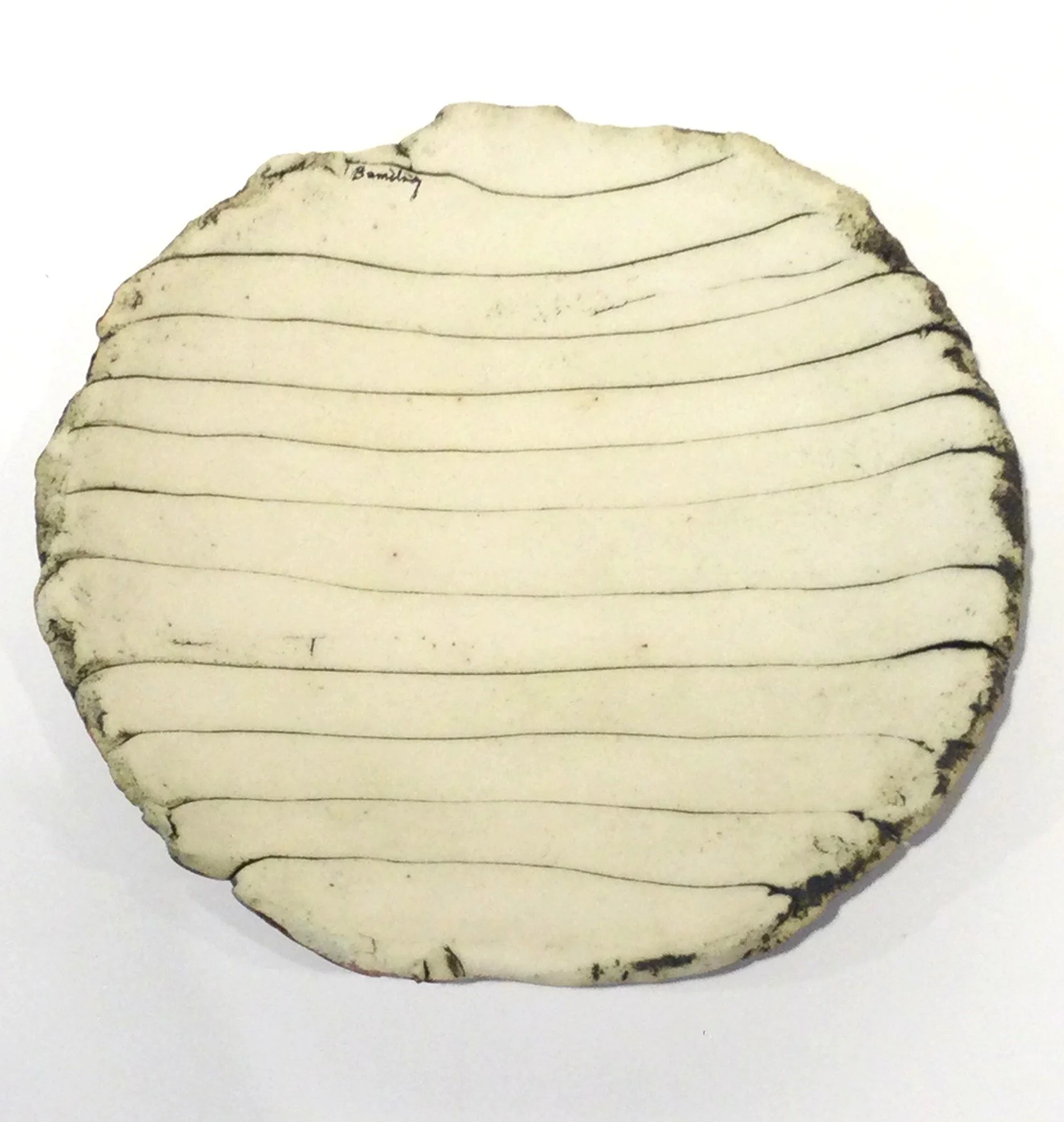
Simple Bowl #25.10, 2025, stoneware, glaze, 2 x 10 inches (5 x 25.5 cm), $450 Cdn.
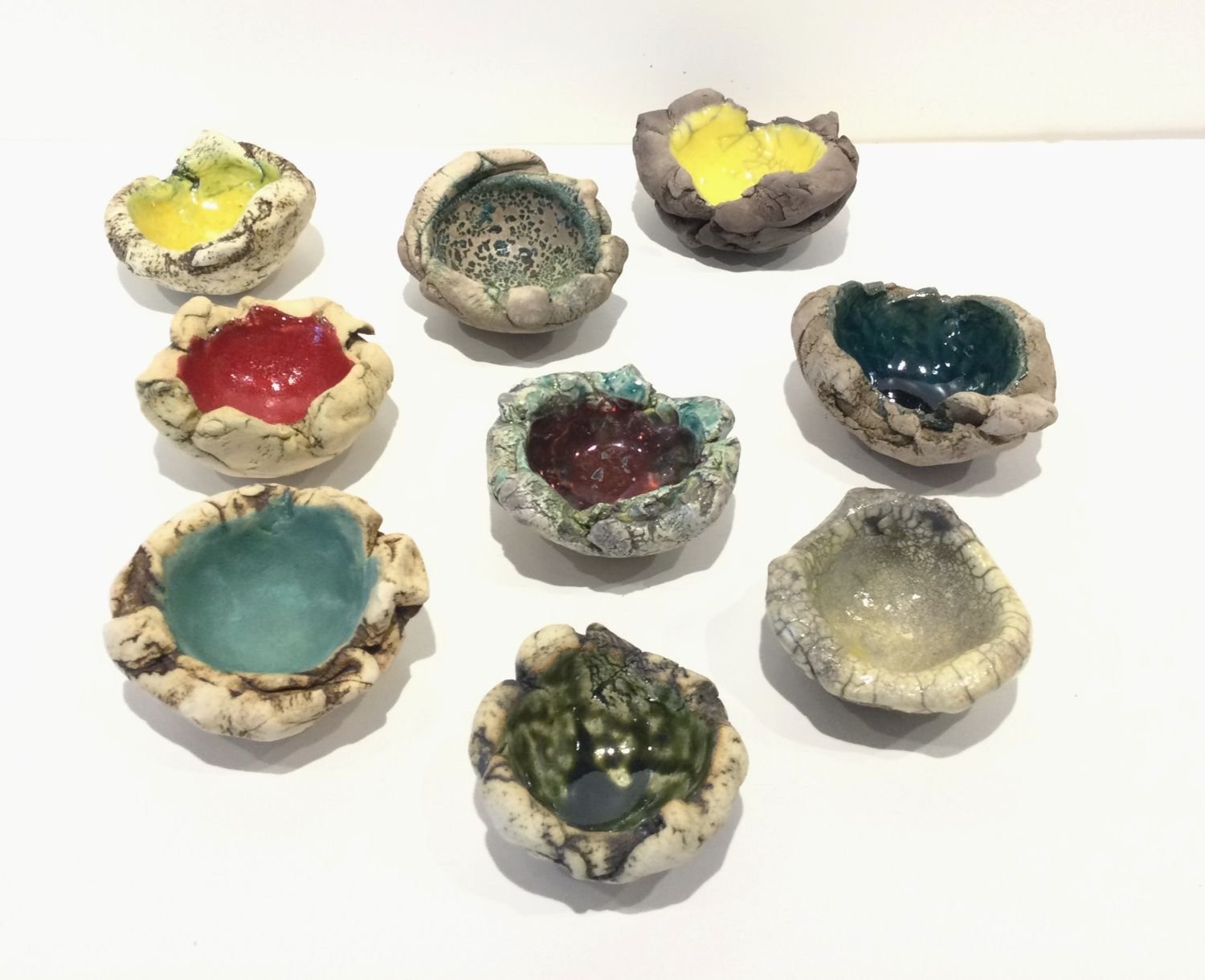
Mini Whimsy Cups, #25-27-1-22, 2025, stoneware, glaze, range of sizes and colours, typically between 1-1.5 x 2.5 x 3 inches (2.5-4 x 6.5-8 cm), $45 Cdn each (contact us for available pieces).
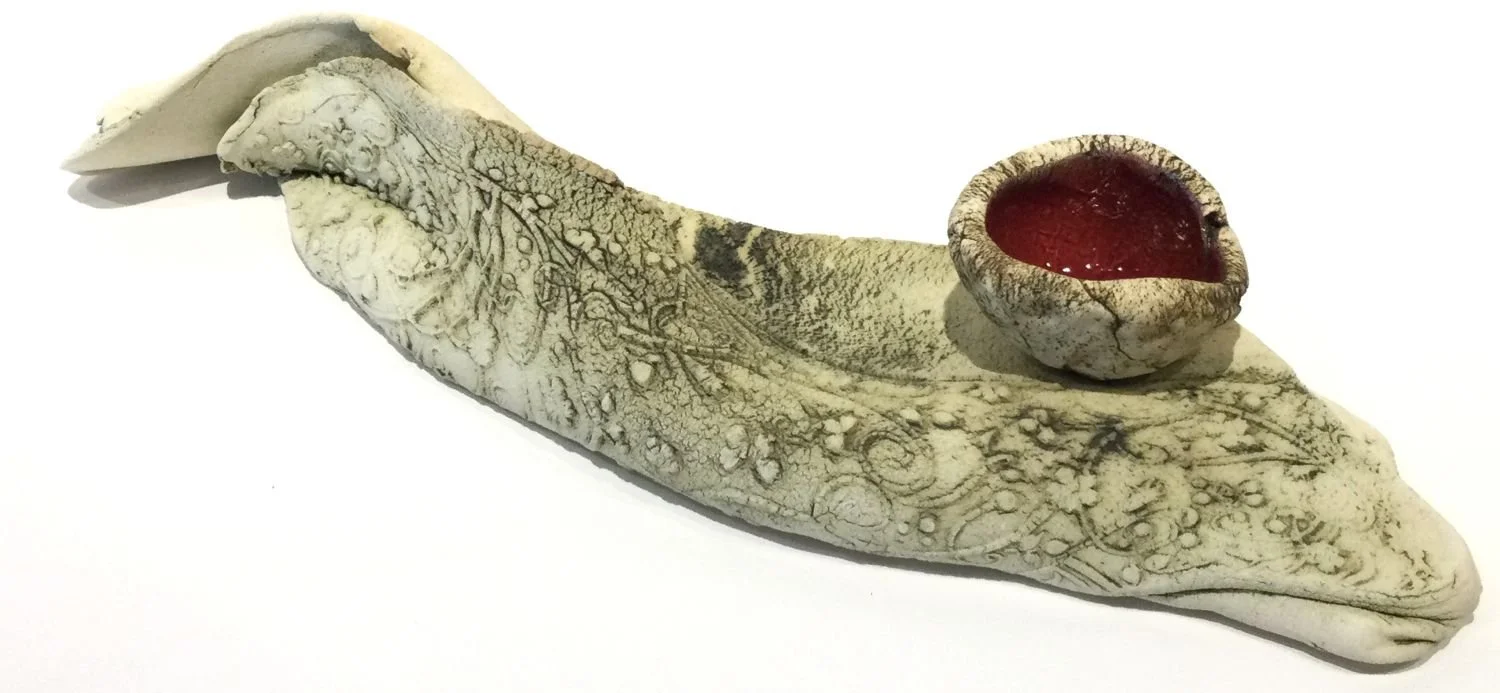
Florid Landscape Cup & Saucer #25.4.11, 2025, 3 x 17 x 5 inches (8 x 43 x 13 cm), $650 Cdn.
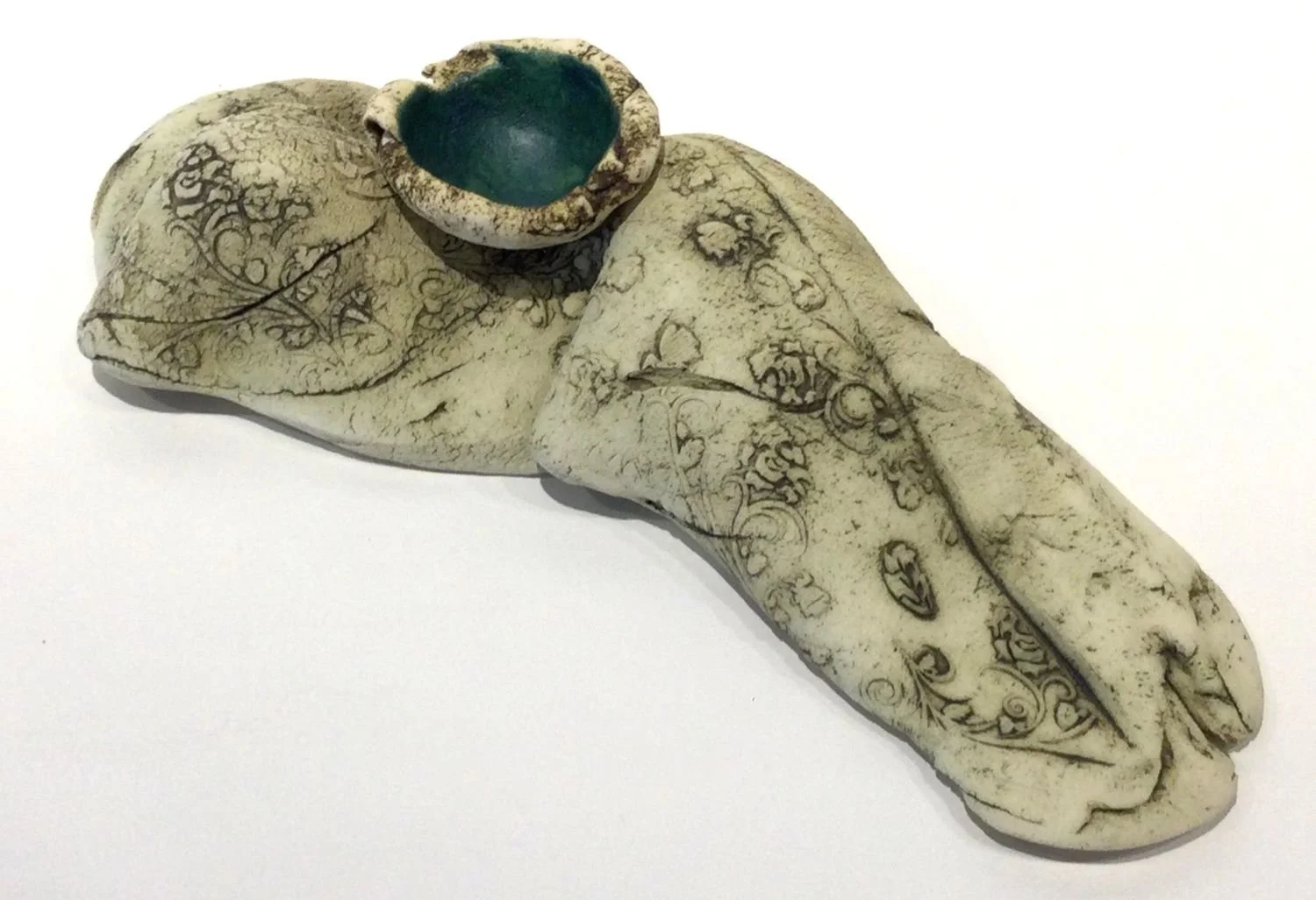
Florid Landscape Cup & Saucer #25.4.12, 2025, 3 x 13.5 x 5.5 inches (8 x 34 x 14 cm), $650 Cdn

Florid Landscape Cup & Saucer #25.4.13, 2025, 3 x 13 x 5 inches (8 x 33 x 12.5 cm), $650 Cdn.
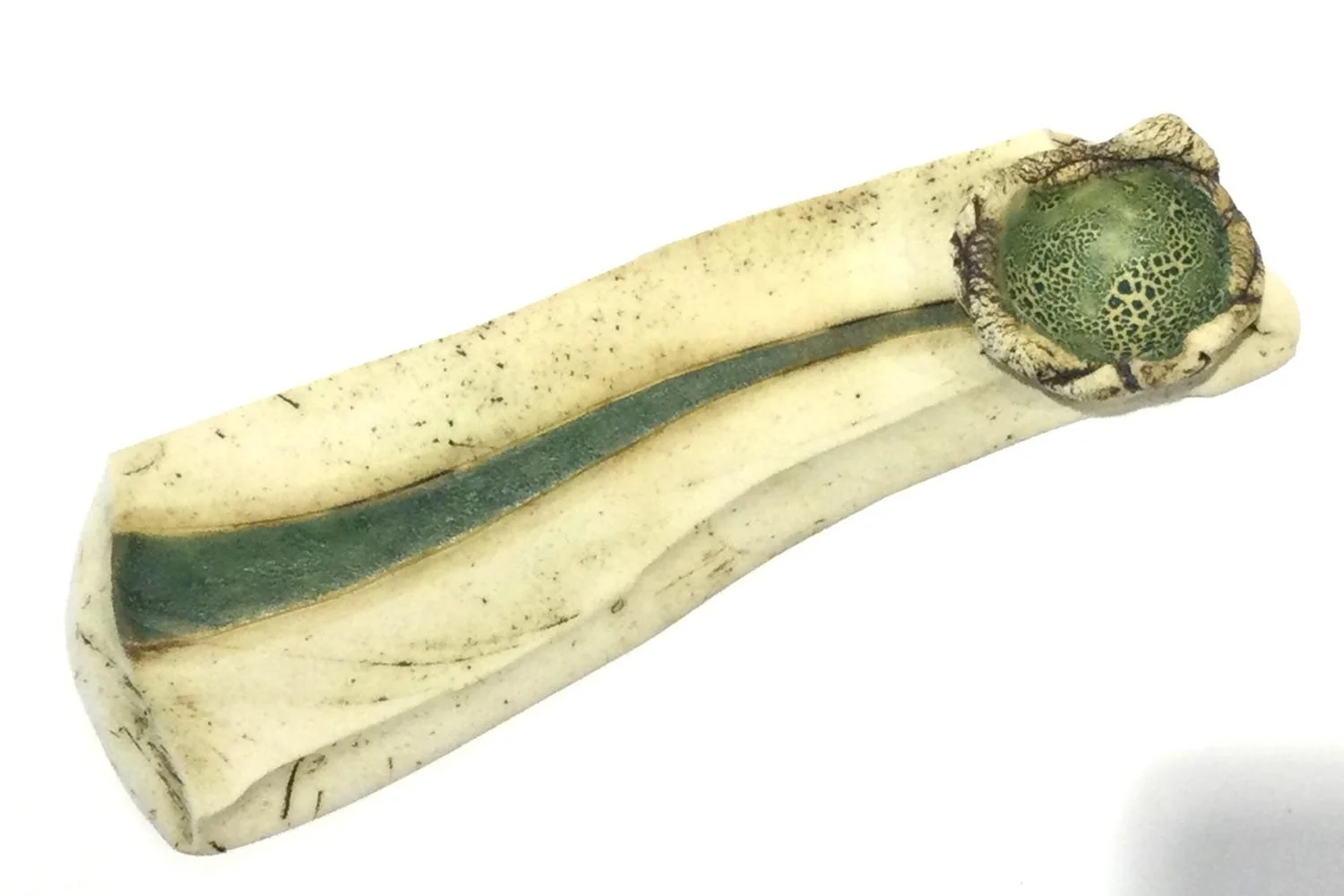
Free-Flowing Landscape Cup & Saucer, #25.14, 2025, stoneware, glaze, 2.5 x 4 x 12 inches (1.5 x 10 x 30.5 cm), $500 Cdn.
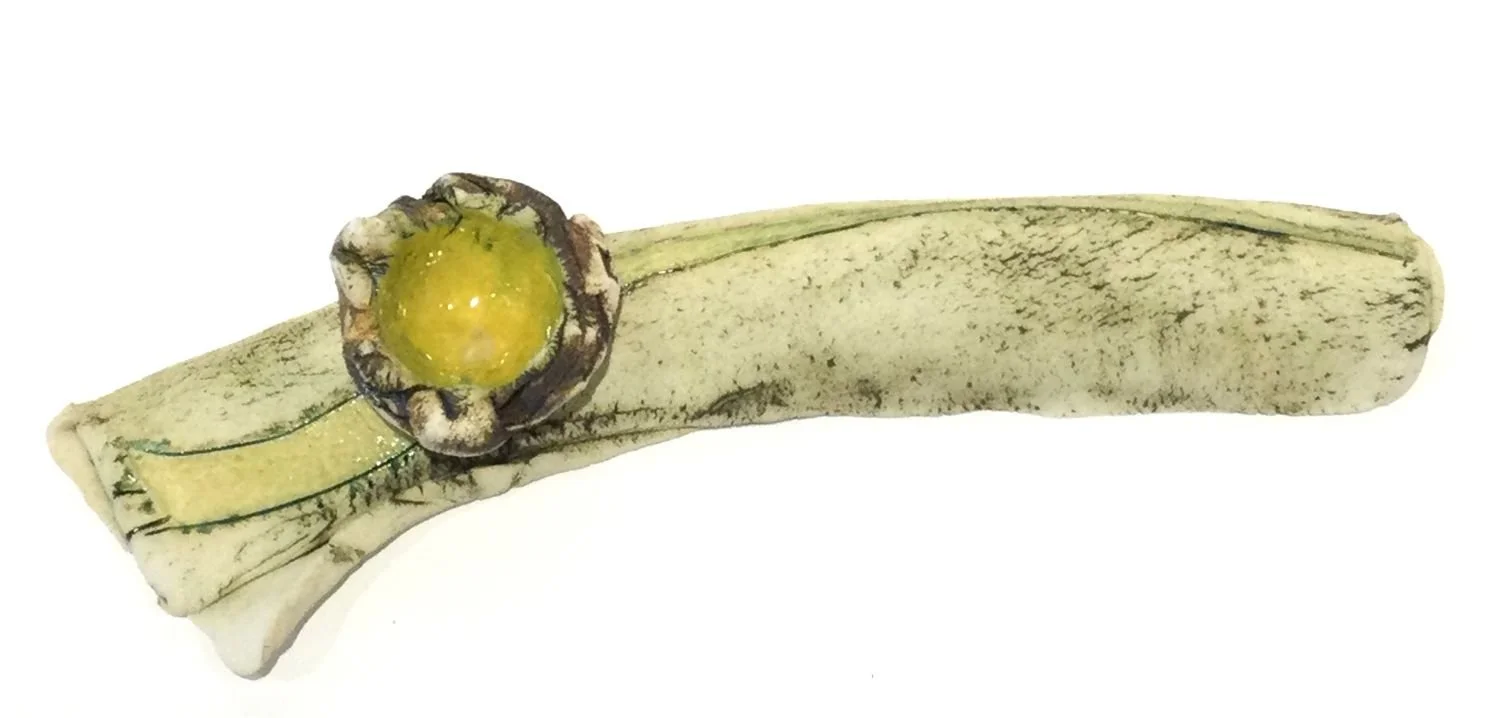
Free-Flowing Landscape Cup & Saucer, #25.15, 2025, stoneware, glaze, 2.5 x 14.5 x 5 inches (6.5 x 37 x 12.5 cm), $500 Cdn.

Free-Flowing Landscape Cup & Saucer, #25.19, 2025, stoneware, glaze, 2 x 11.5 x 6.5 inches (5 x 30 x 11 cm), $500 Cdn.

Free-Flowing Landscape Cup & Saucer, #25.16, 2025, stoneware, glaze, 2.5 x 15 x 3.5 inches (6.5 x 38 x 9 cm), $500 Cdn.
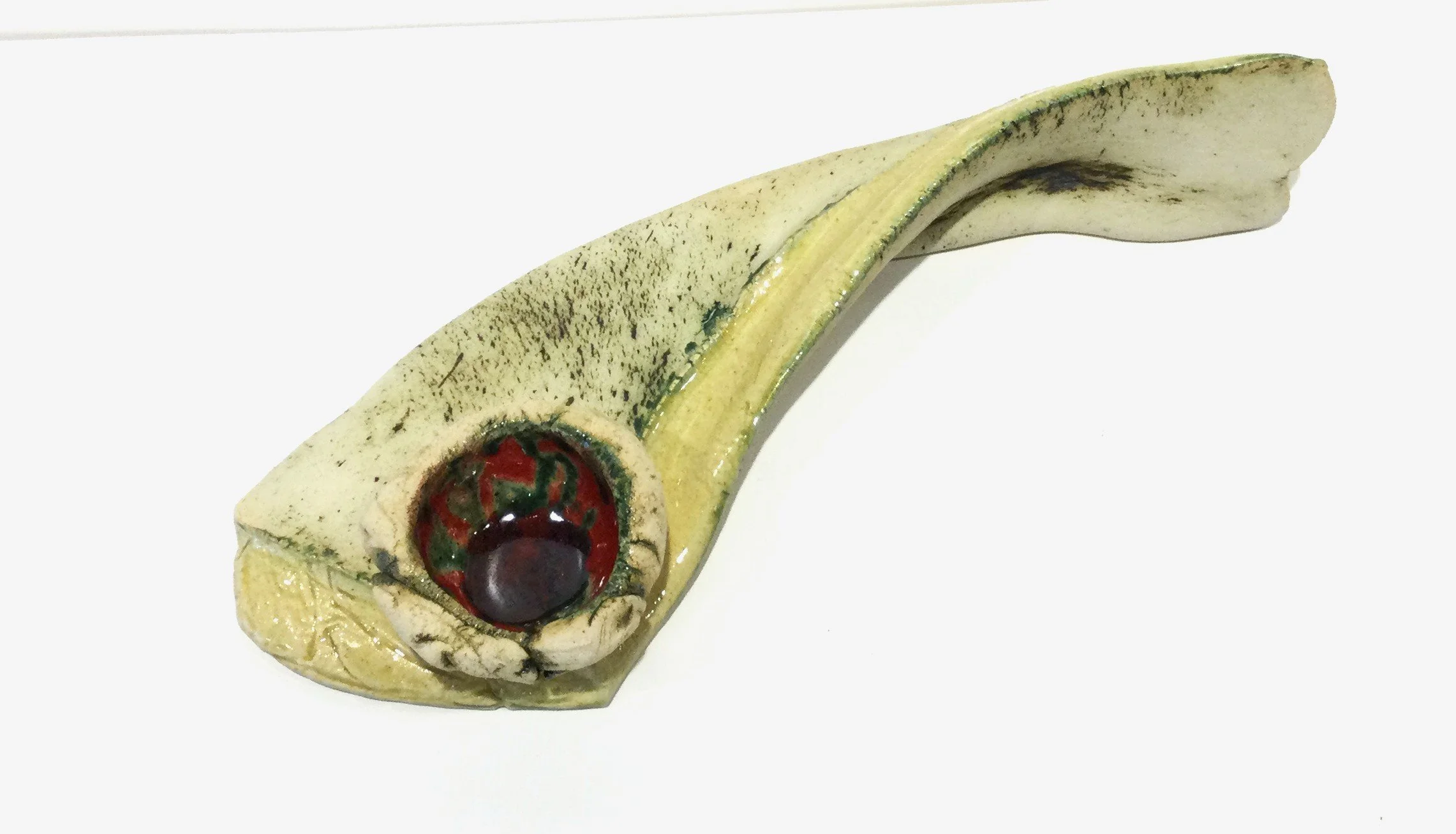
Free-Flowing Landscape Cup & Saucer, #25.17, 2025, stoneware, glaze, 2.25 x 12 x 5 inches (6 x 31 x 12 cm), $500 Cdn.
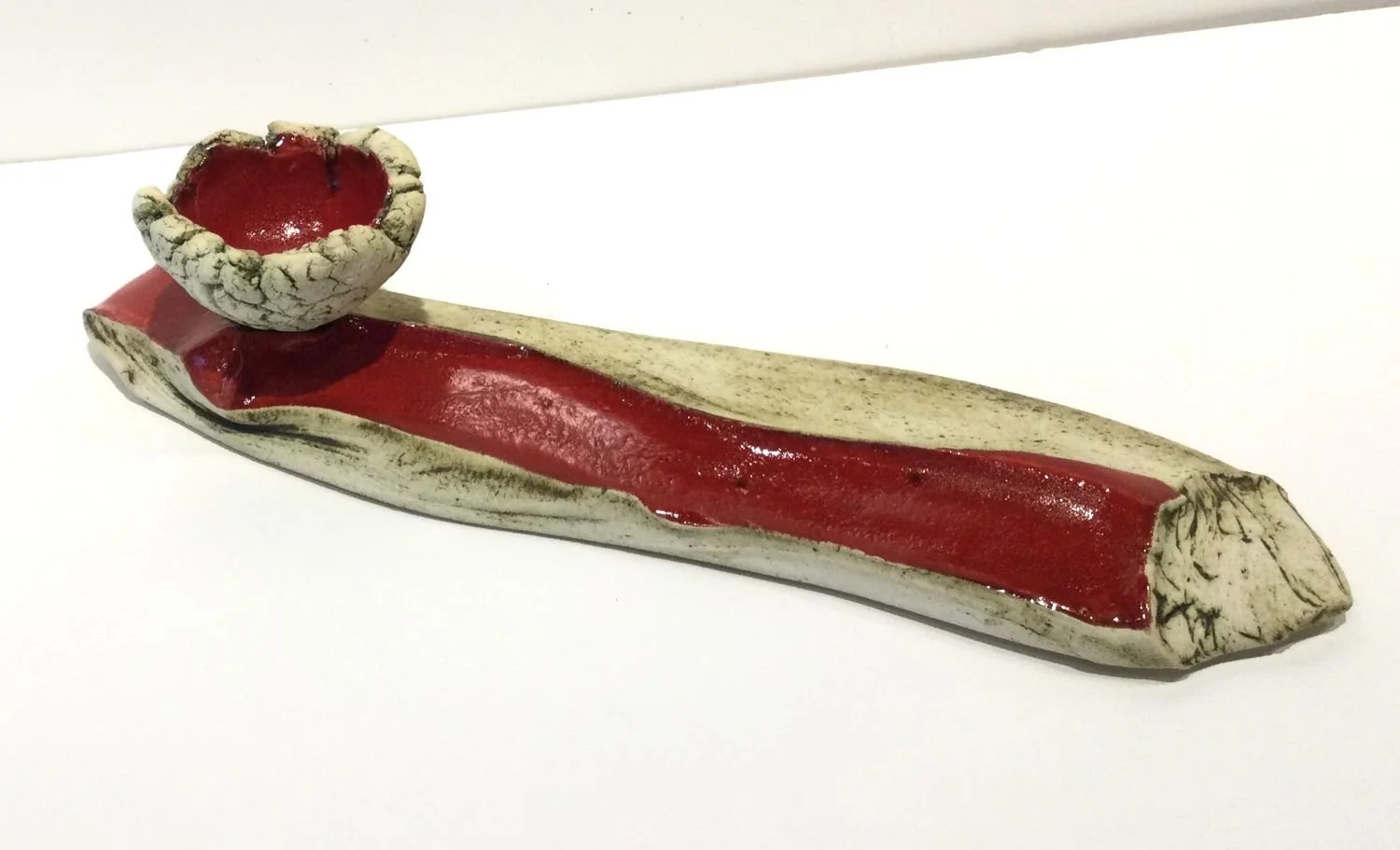
Free-Flowing Landscape Cup & Saucer, #25.18, 2025, stoneware, glaze, 3 x 12.5 x 4 inches (7.5 x 32 x 10 cm), $500 Cdn.

Free-Flowing Landscape Cup & Saucer, #25.20, 2025, stoneware, glaze, 4 x 10 x 3.5 inches (10 x 26 x 9 cm), $500 Cdn.

Impressed Slab(s), #25.21-6, 2025, stoneware, 7 x 4.25 x 1.75 inches (18 x 11 x 2 cm) each slab, $225 Cdn each (set of 6 slabs $1170 Cdn).
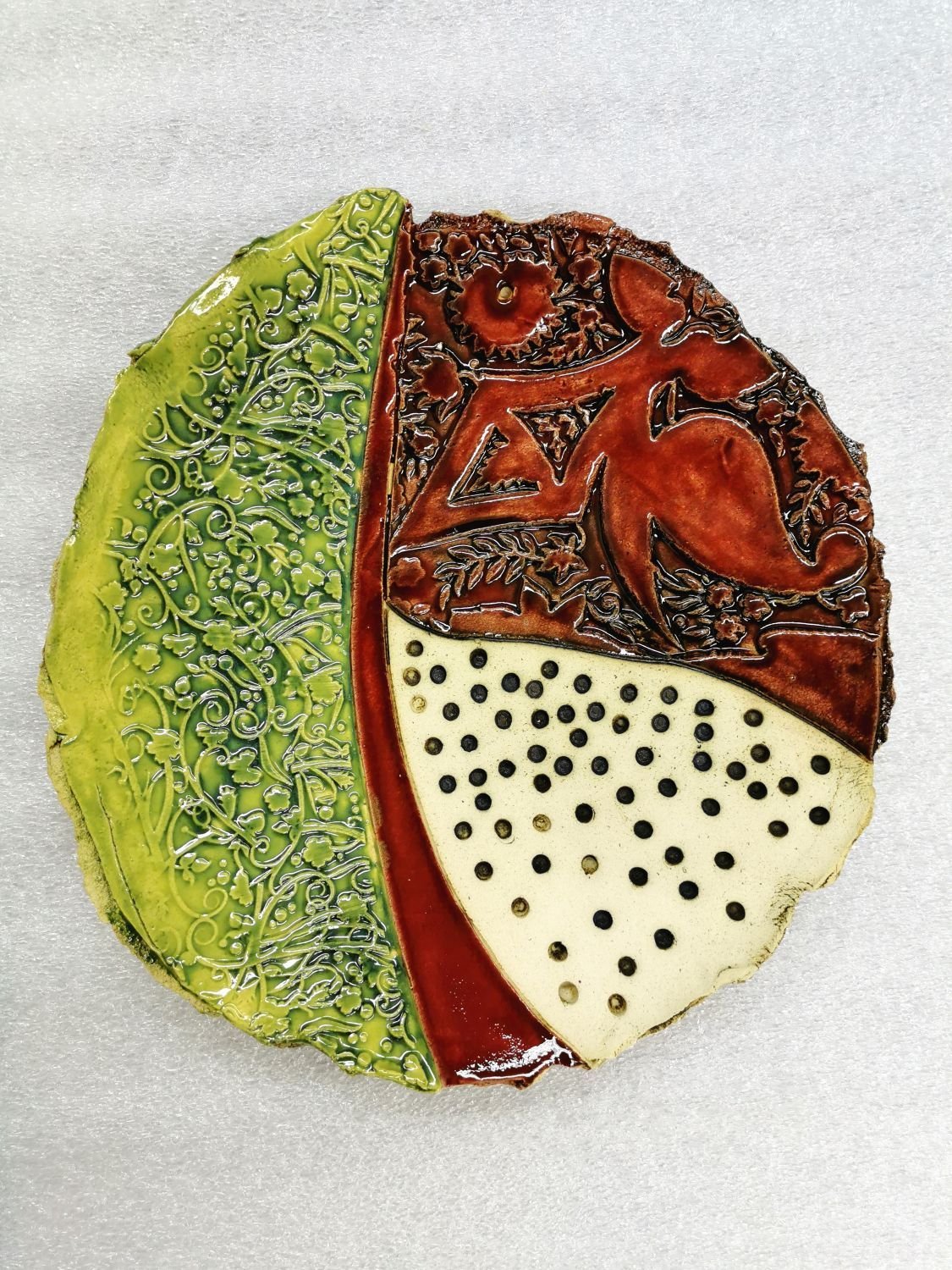
Impressed Bowl #25.5, glazed and impressed stoneware, 1.5 x 10 inches (4x25.5 cm), sold

Impressed Bowl #25.6, glazed and impressed stoneware, 1.5 x 10 inches (4x25.5 cm), sold

Simple Bowl #25.9, 2025, stoneware, glaze, 2 x 10 inches (5 x 25.5 cm), sold.
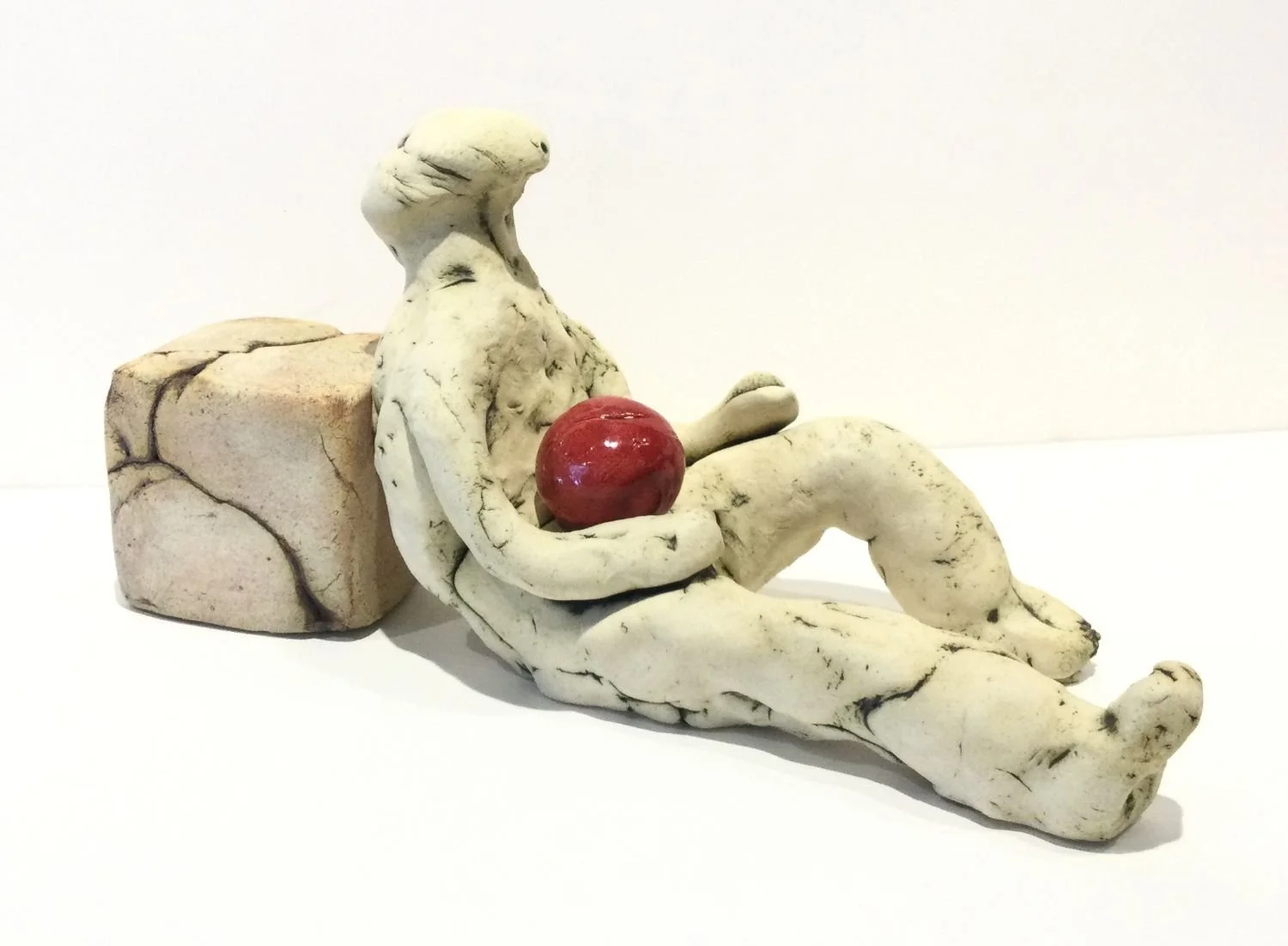
The Dreamers #28, 2025, stoneware and glaze, 6 x 11 x 4.5 inches (15 x 28 x 11 cm), $600 Cdn.
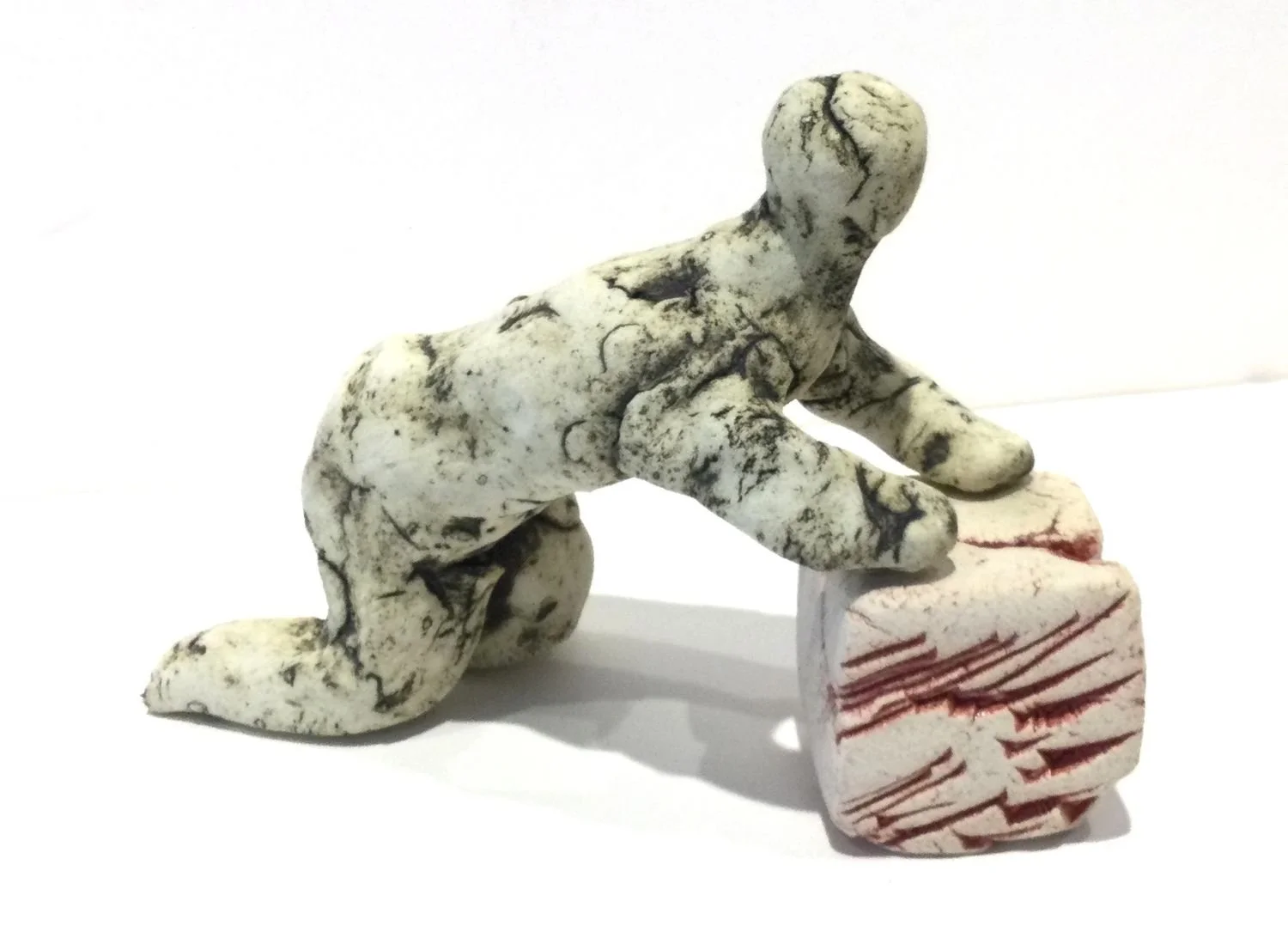
The Dreamers #30, 2025, stoneware, glazes, oxide, 4.5 x 6.25 x 2.5 inches (12 x 16 x 6.5 cm), $400 Cdn.
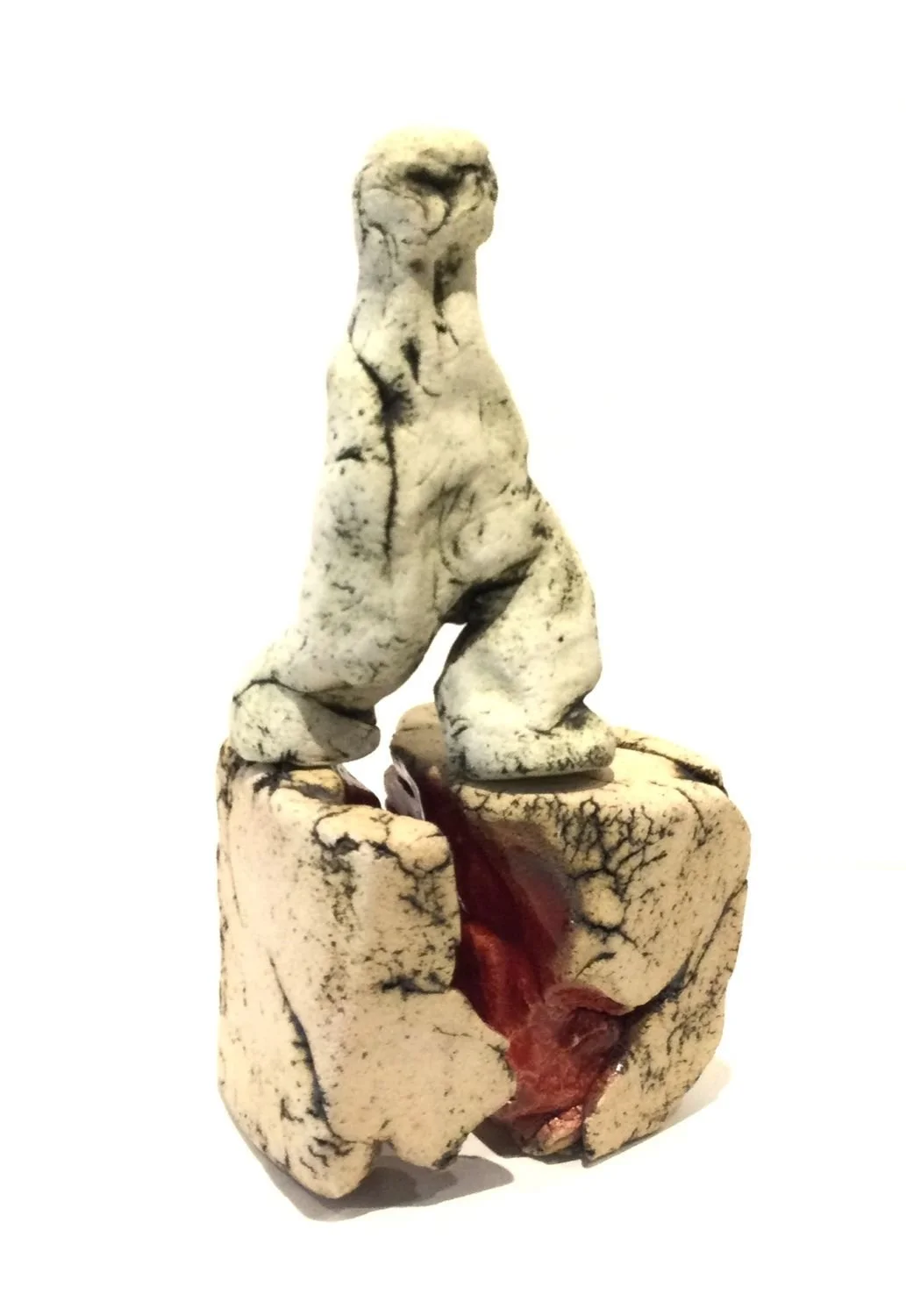
The Dreamers #31, 2025, stoneware, glaze, 7 x 3.5 x 2.5 inches (18 x 9 x 7 cm), $400 Cdn.
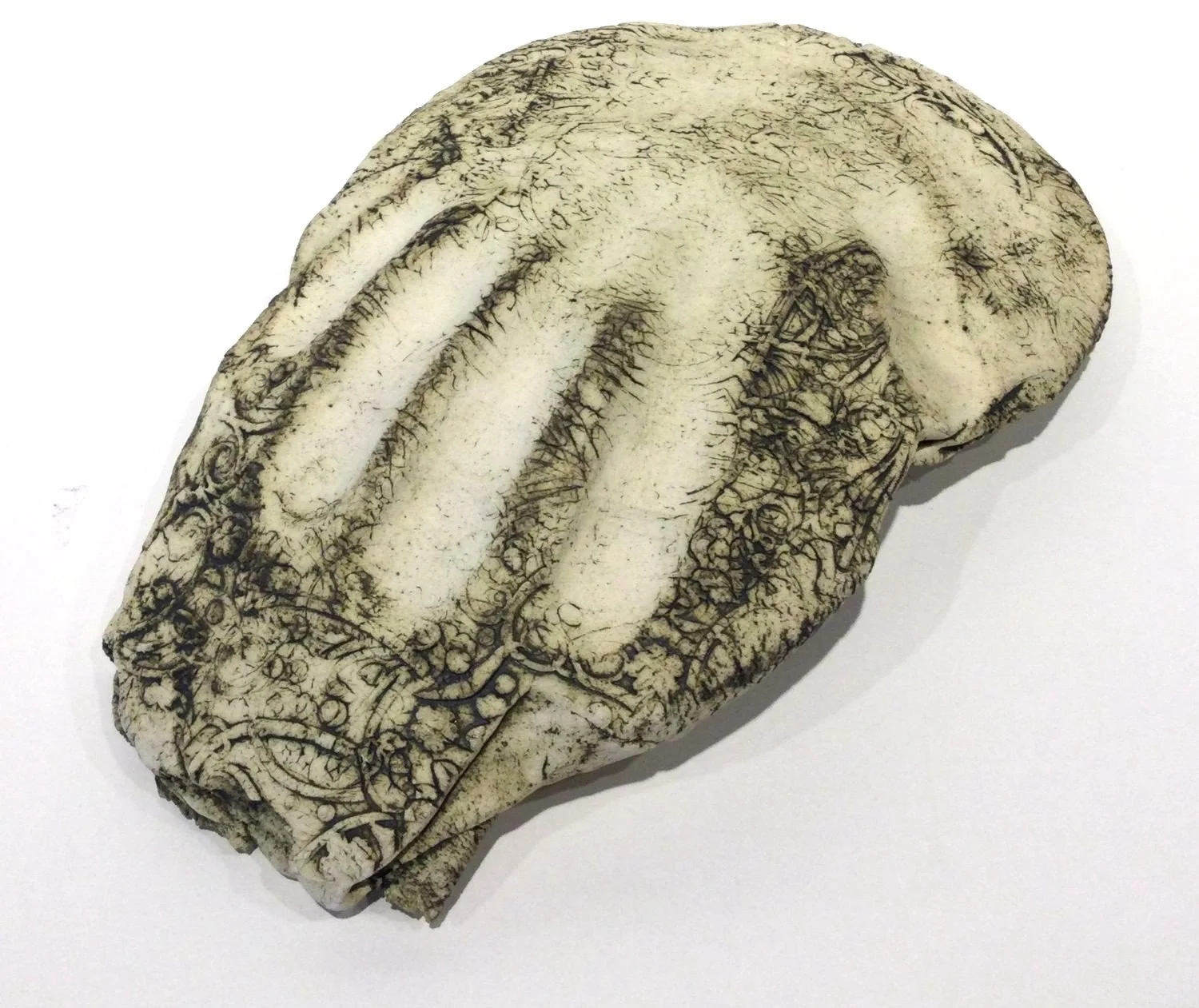
Executive Worry Stone #25.34, 2025, stoneware, 1.5 x 9 x 6 inches (4 x 23 x 15 cm), $375 Cdn.
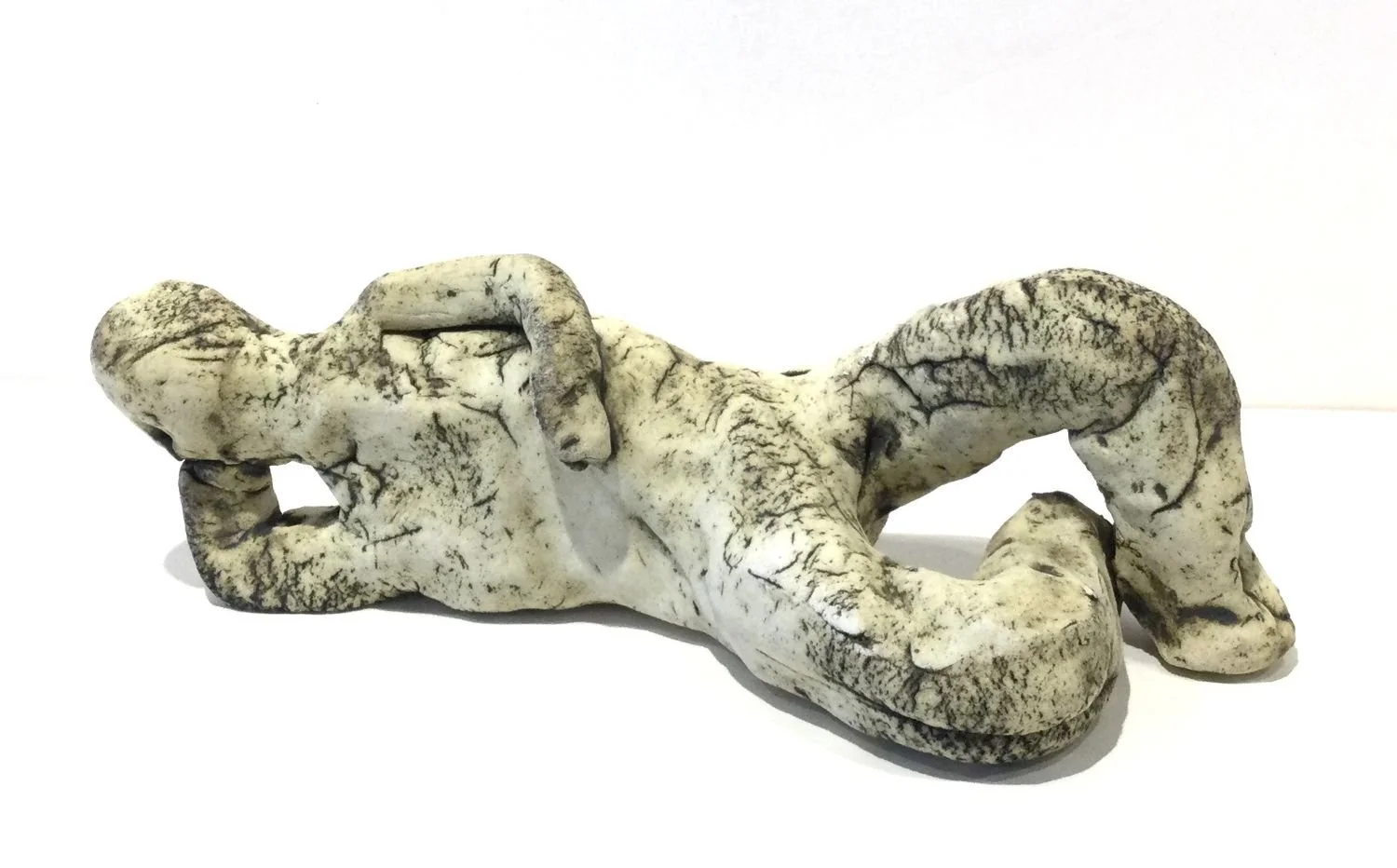
The Dreamers #32-4, 2025, stoneware, 3 x 9 x 4 inches (8 x 23 x 10 cm), $325 Cdn.

The Dreamers #32-1, 2025, stoneware, 6.5 x 3.5 x 2.5 inches (16.5 x 9 x 7 cm), $325 Cdn.
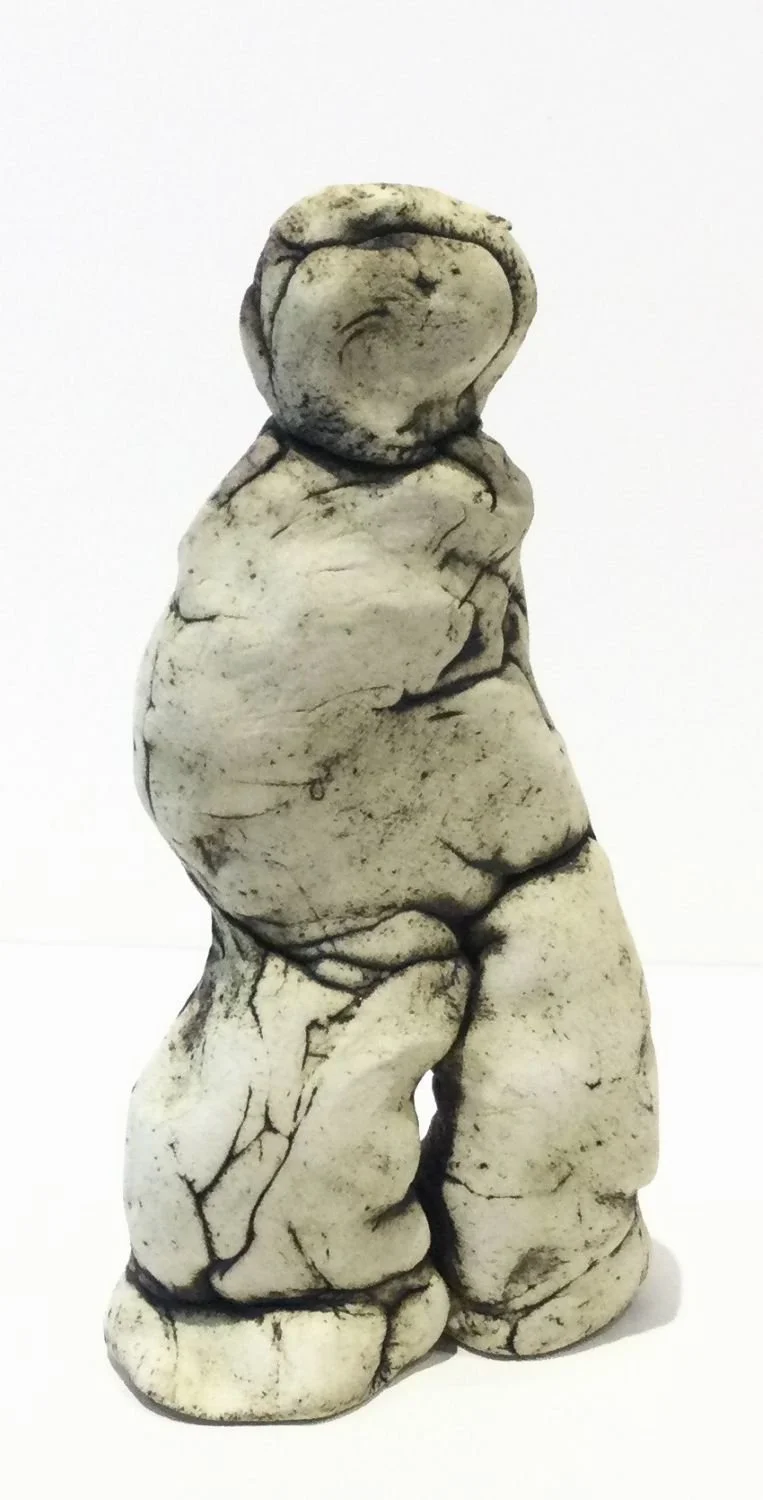
The Dreamers #32-2, 2025, stoneware, 6 x 3.5 x 2.5 inches (15 x 9 x 7 cm), $325 Cdn.
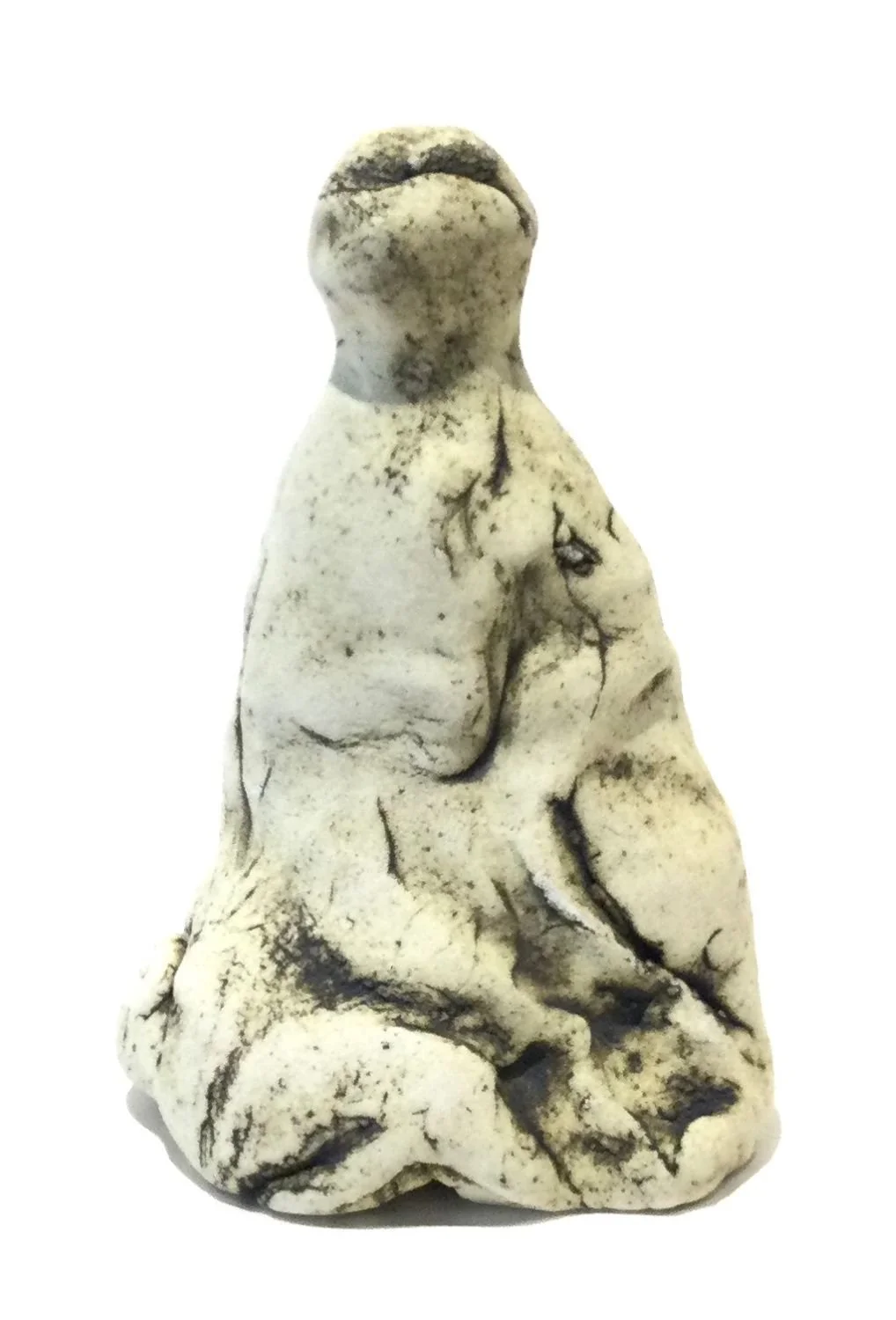
The Dreamers #32-3, 2025, stoneware, 5.5 x 3.5 x 3 inches (14 x 9 x 7.5 cm), $325 Cdn.
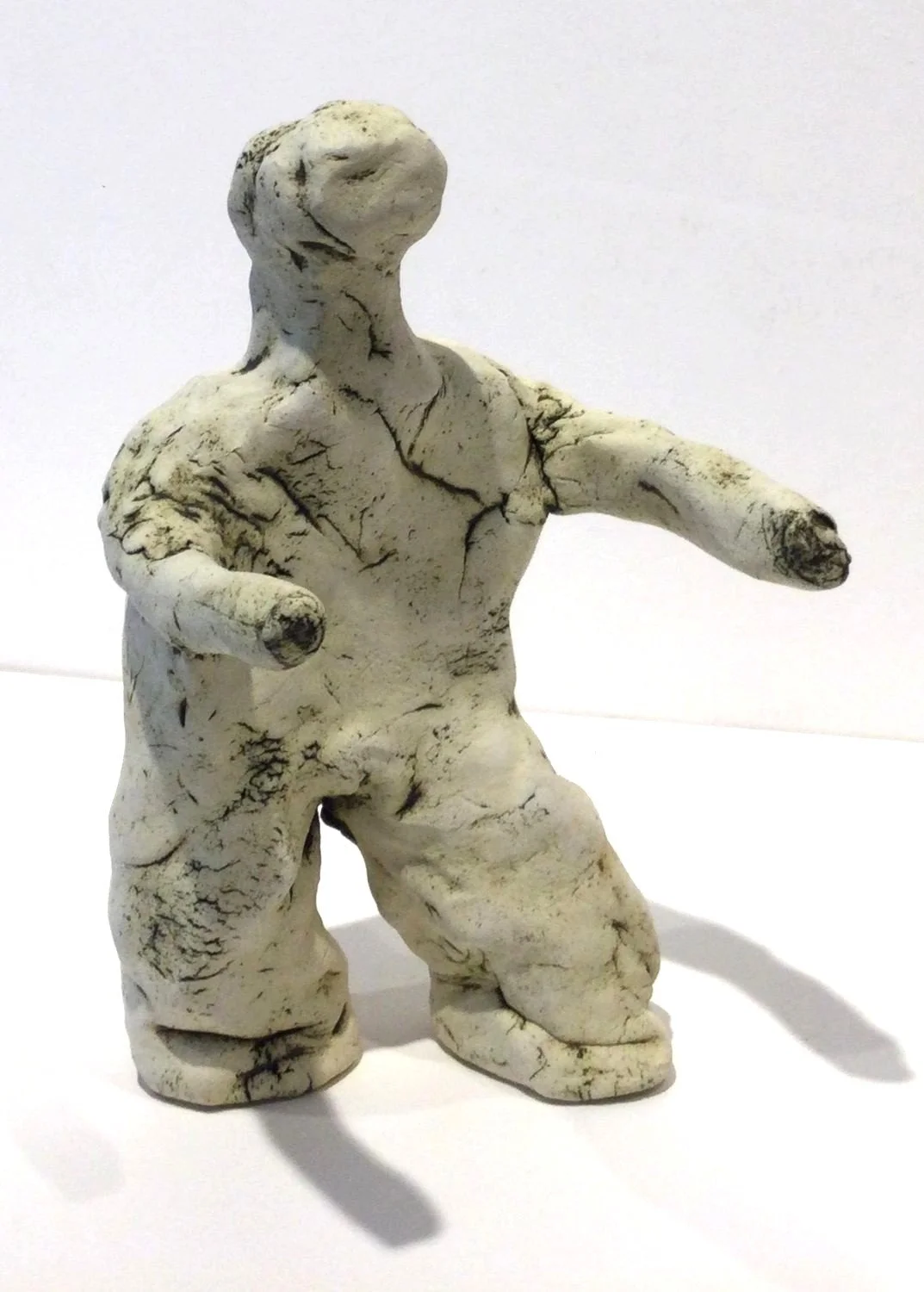
The Dreamers #32.6, 2025, stoneware, 7.5 x 3 x 4 inches (19 x 8 x 11 cm), $325 Cdn.
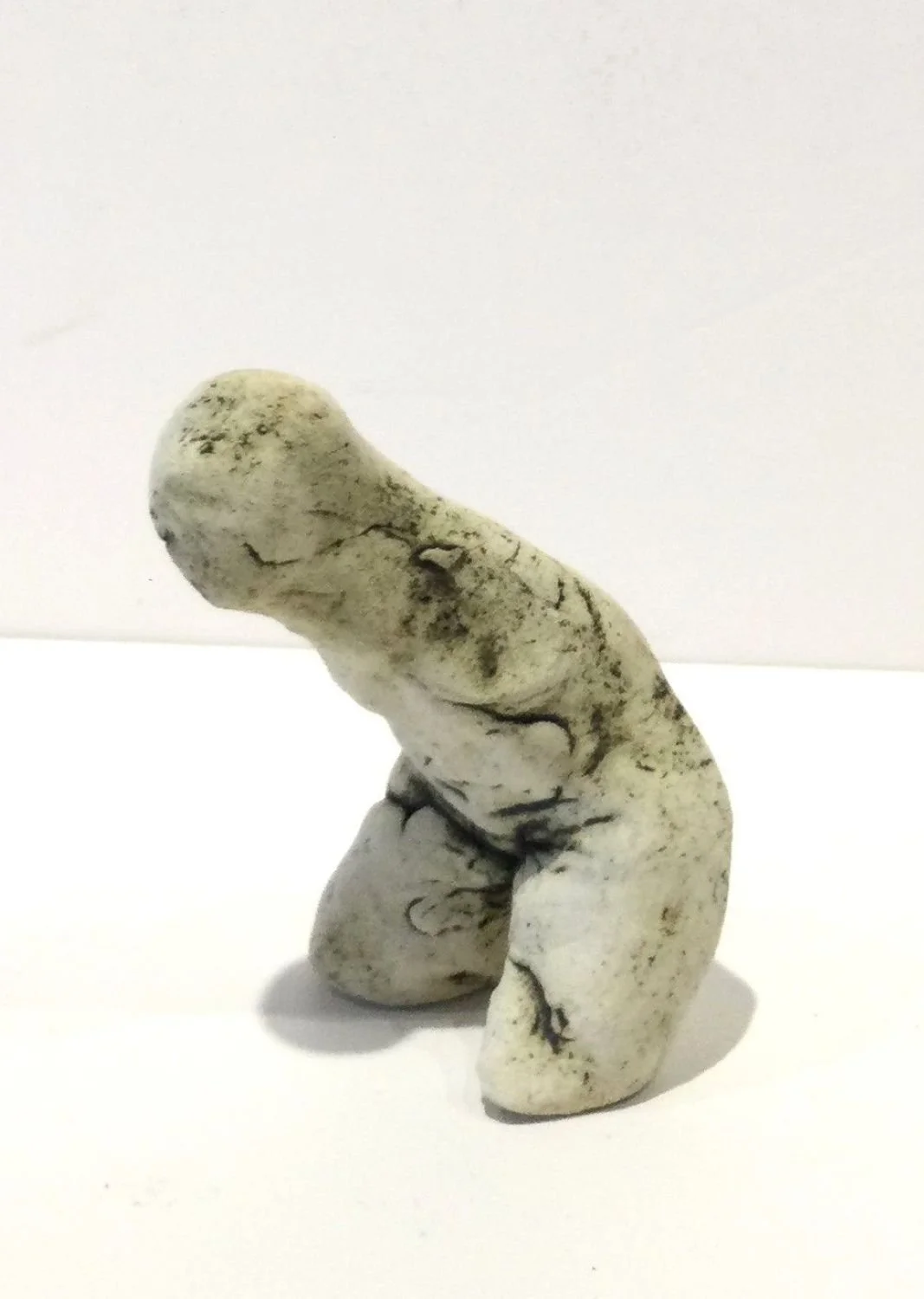
The Dreamers #33-1, 2025, stoneware, 3.5 x 2 x 2 inches (9 x 5 x 5 cm), $250 Cdn.

The Dreamers #33-2, 2025, stoneware, 3.5 x 3 x 2.5 inches (9 x 7.5 x 6.5 cm), $250 Cdn.

The Dreamers #33-4, 2025, stoneware, 3 x 2.5 x 1.5 inches (7.5 x 6.5 x 4 cm), $250 Cdn.
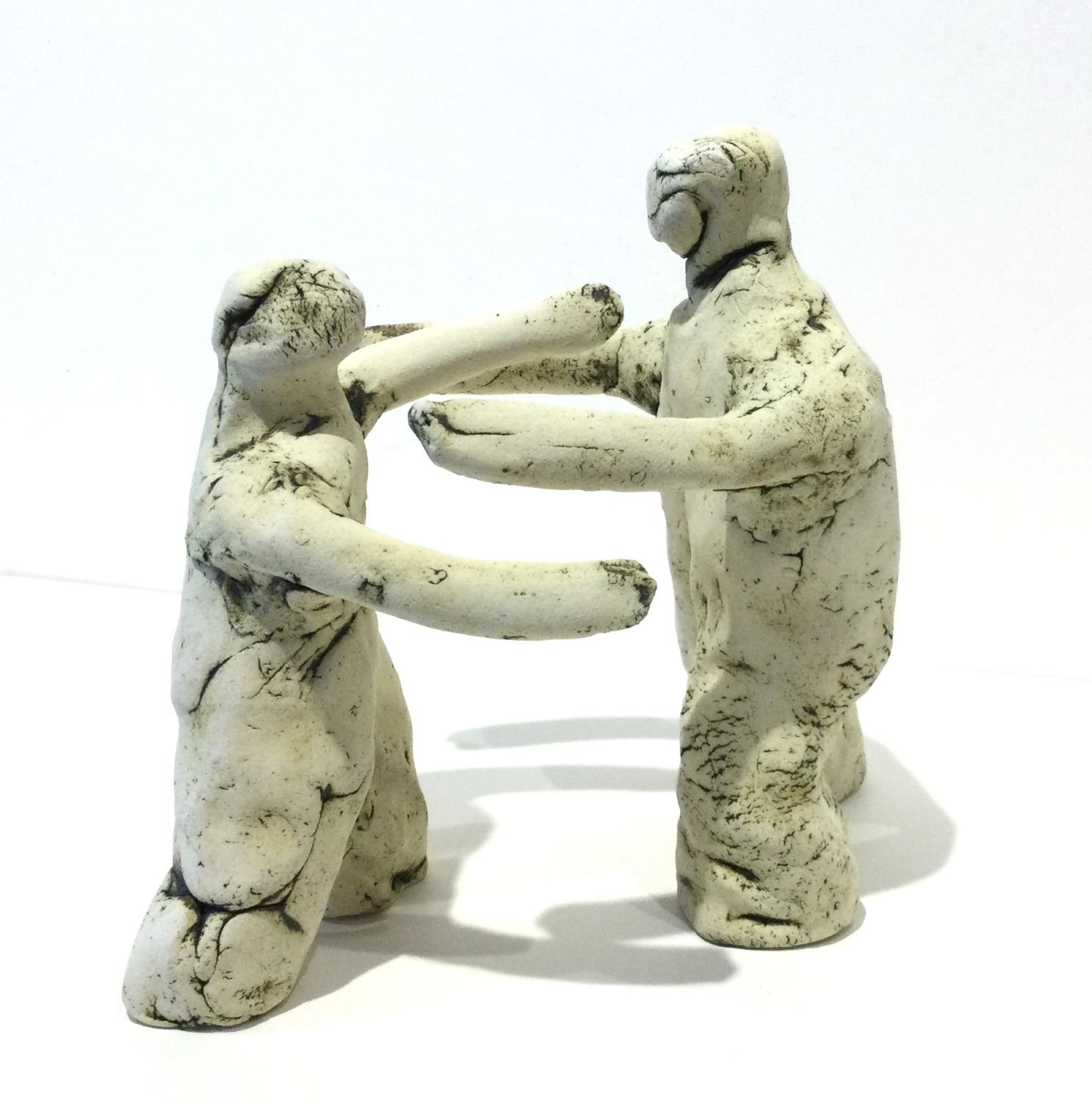
The Dreamers #32.7 and #32.8, 2025, stoneware, 7.5 x 3 x 2 inches (19 x 8 x 5 cm) each, $325 Cdn each.
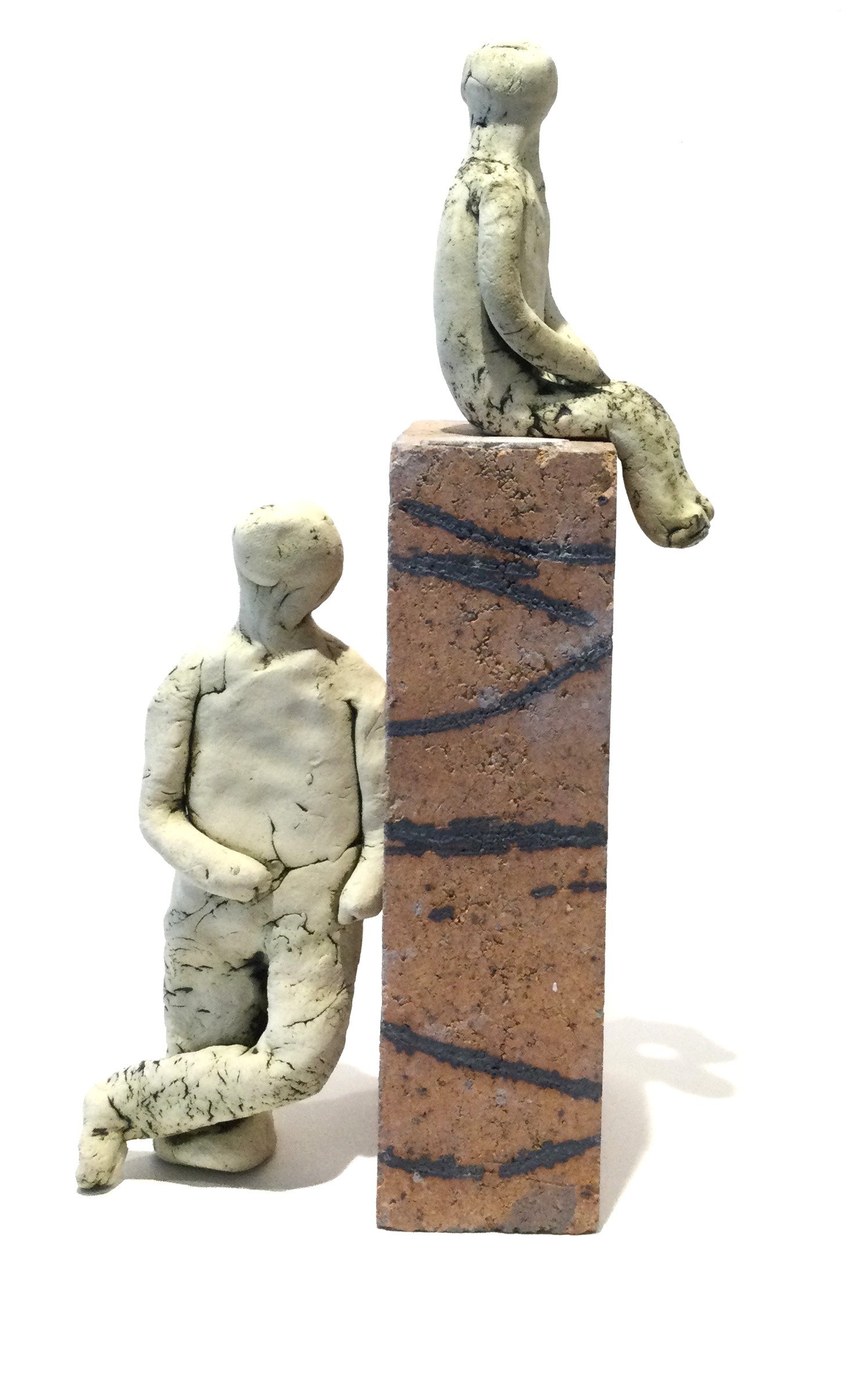
The Dreamers #29, 2025, stoneware, brick, 14 x 7 x 4.5 inches (35.5 x 17.5 x 11.5 cm), sold.
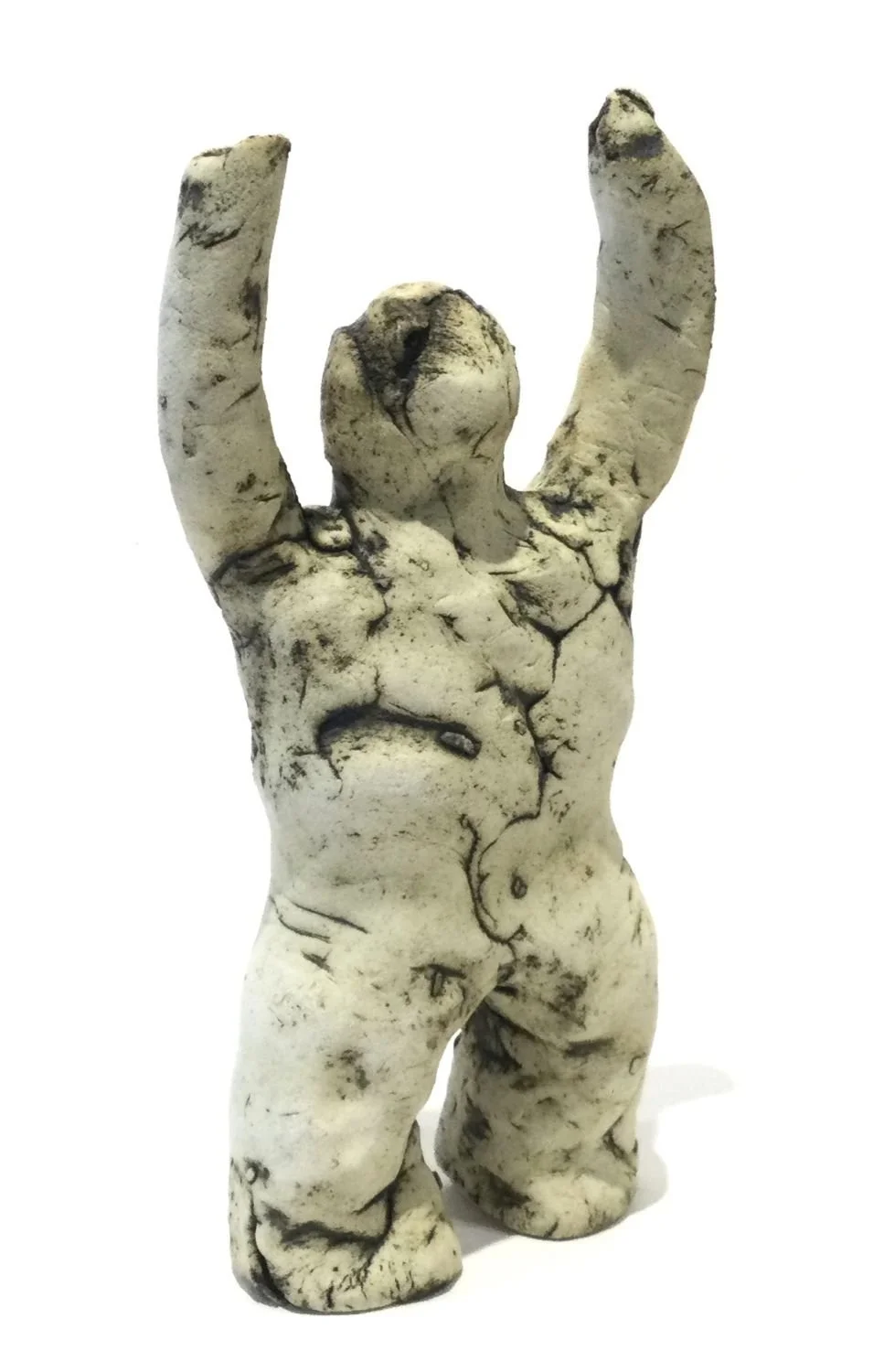
The Dreamers #32.5, 2025, stoneware, 7.5 x 3 x 2 inches (19 x 8 x 5 cm), sold.
Paper Clay & Stoneware
Ed Bamiling has been a practicing artist for over 40 years and has worked with many processes including paper clay since, as a young artist, he participated in the development of the paper clay process at the Banff Centre. As he worked with the medium it shaped his consideration of ceramic process and aesthetics, which moved him to explore beyond the normal boundaries and incorporate concepts of the found object intermingled with a play with traditional form.

Fragmented Cup With Red Sphere (14.3), paperclay, stoneware, oxides, glazes, 9 x 7 x 5 inches (23 x 17 x 2.5 cm), $750 Cdn.

The Deep Space Dish (19.16), paper clay, oxides, glazes, 10 x 2 x 10 inches (25 x 5 x 25 cm), $350 Cdn.
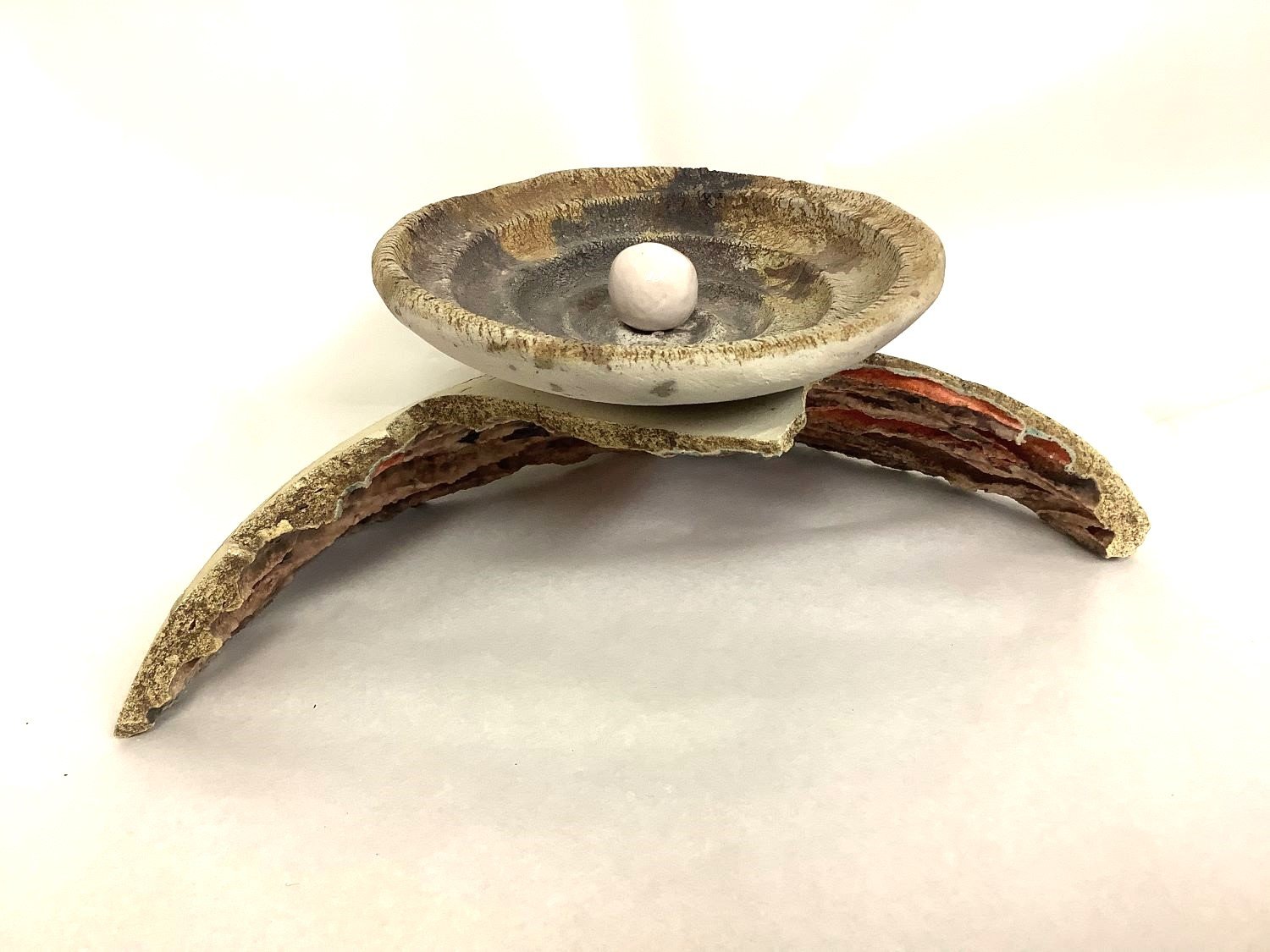
Vortex Cup With Overhang (14.1), paperclay, stoneware, oxides, glazes, 4 x 10.5 x 5.5 inches (10 x 27 x 14 cm), $750 Cdn.
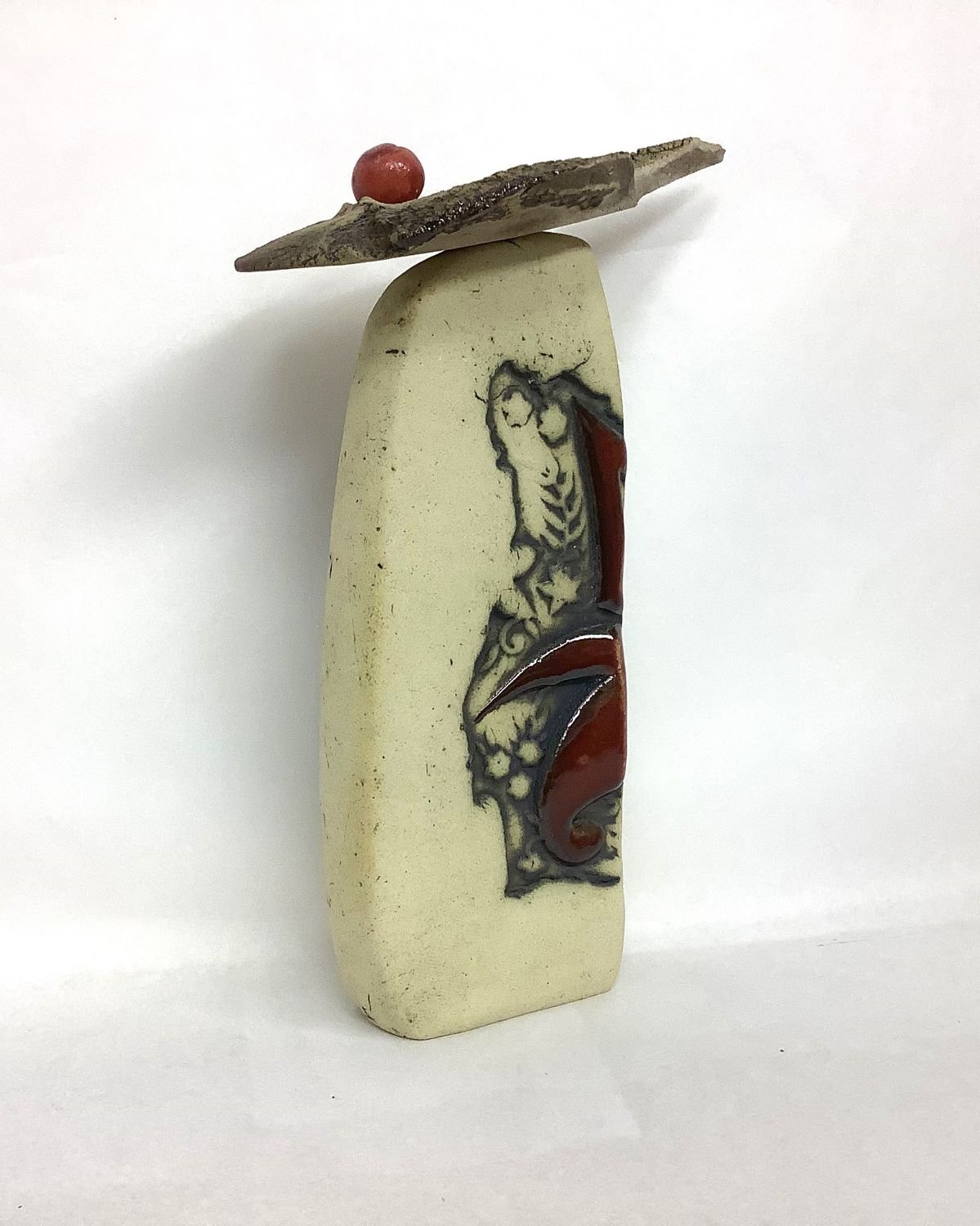
The Lightness Of Being (#22.12.2), paperclay, stoneware, oxides, glazes, 10 x 7 x 3 inches (25 x 18 x 7.5 cm), $475 Cdn.

Genesis Dish (19.11), paper clay, oxides, glazes, 1.5 x 8 x 8 inches (4 x 20 x 20 cm), $300 Cdn.
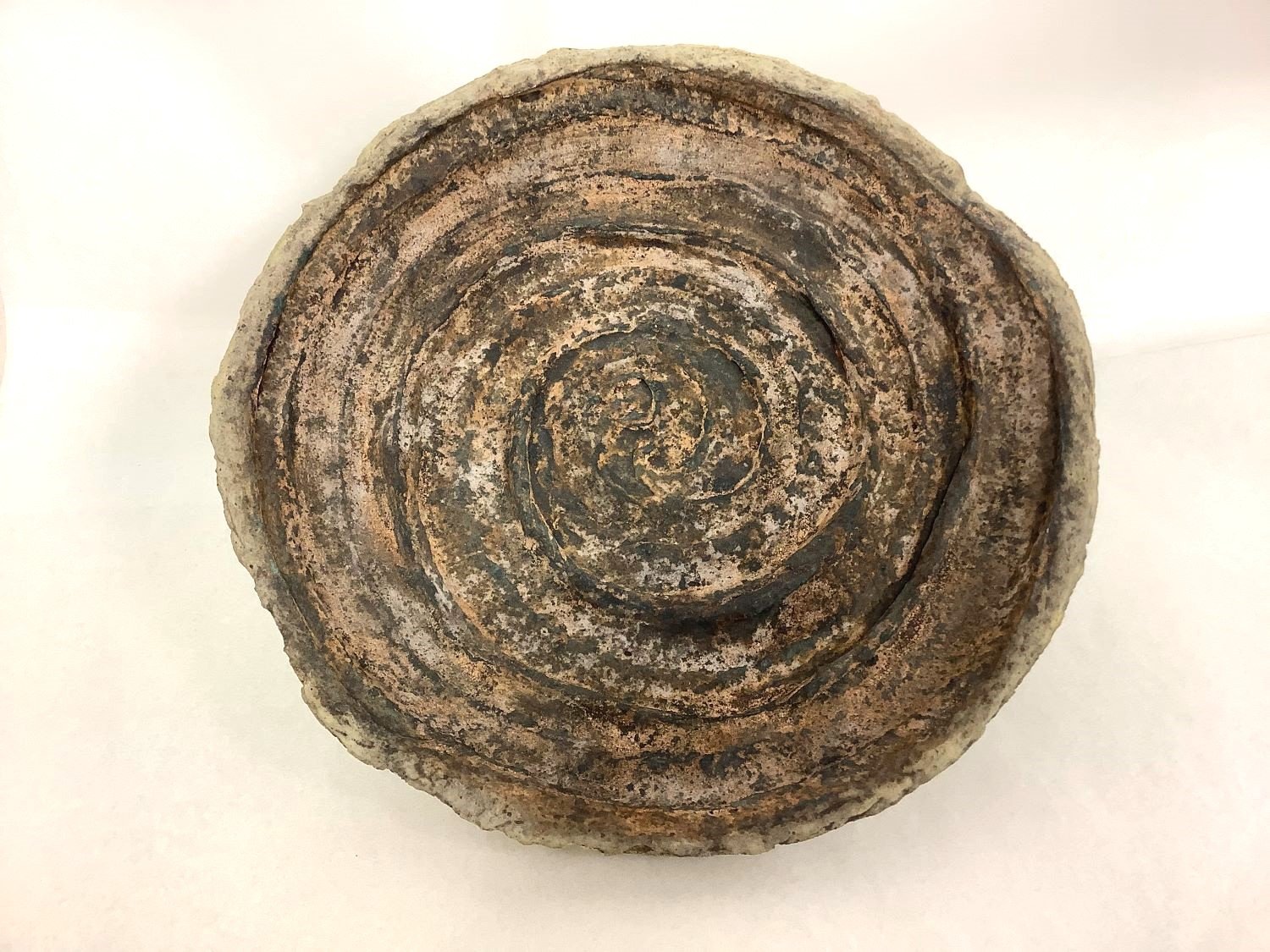
Earthly Dish (19.3), paper clay, oxides, glazes, 2 x 10 x 10 inches (5 x 27 x 27 cm), $400 Cdn.

Oblong Cup With Double Saucer (14.6), paperclay, stoneware, oxides, glazes, 3 x 14 x 5.5 inches (8 x 35 x 14 cm), $800 Cdn.

Stone Carpet (#40), 2023, paperclay, stoneware, oxides, glazes, 12.5 x 3 x 5 inches (30 x 7.5 x 13 cm), $450 Cdn.
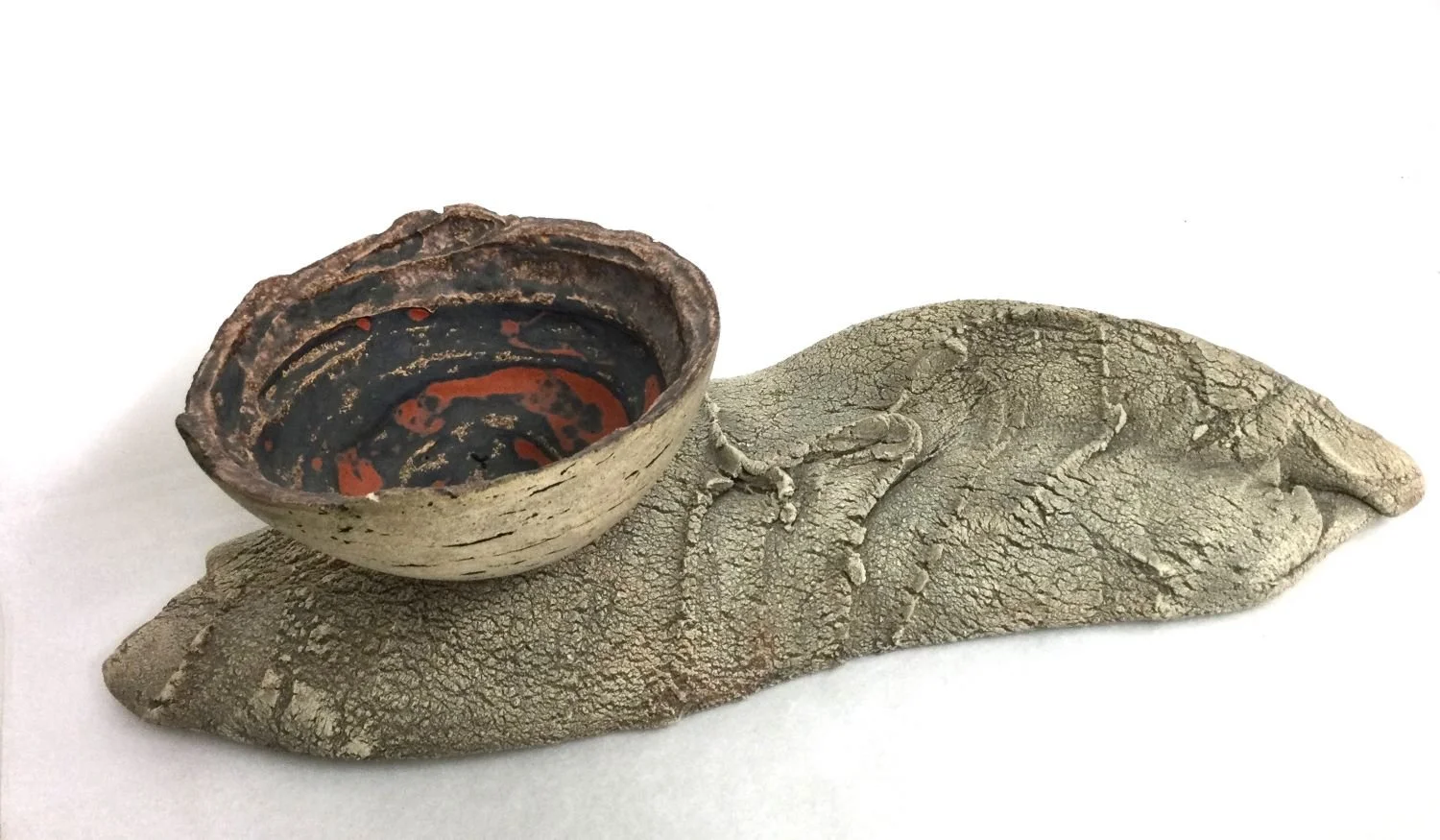
Red & Black Cup & Saucer (13.1), 2 pieces (13.2), paperclay, stoneware, oxides, glazes, 4.5 x 15.75 x 6.75 inches (11.5 x 40 x 15.75 cm), $750 Cdn.

Mottled Blue Cup & Saucer, 2 pieces (13.2), paper clay, stoneware, oxides, glazes, 4.5 x 15.5 x 6 inches (11 x 39 x 15 cm), $750 Cdn.
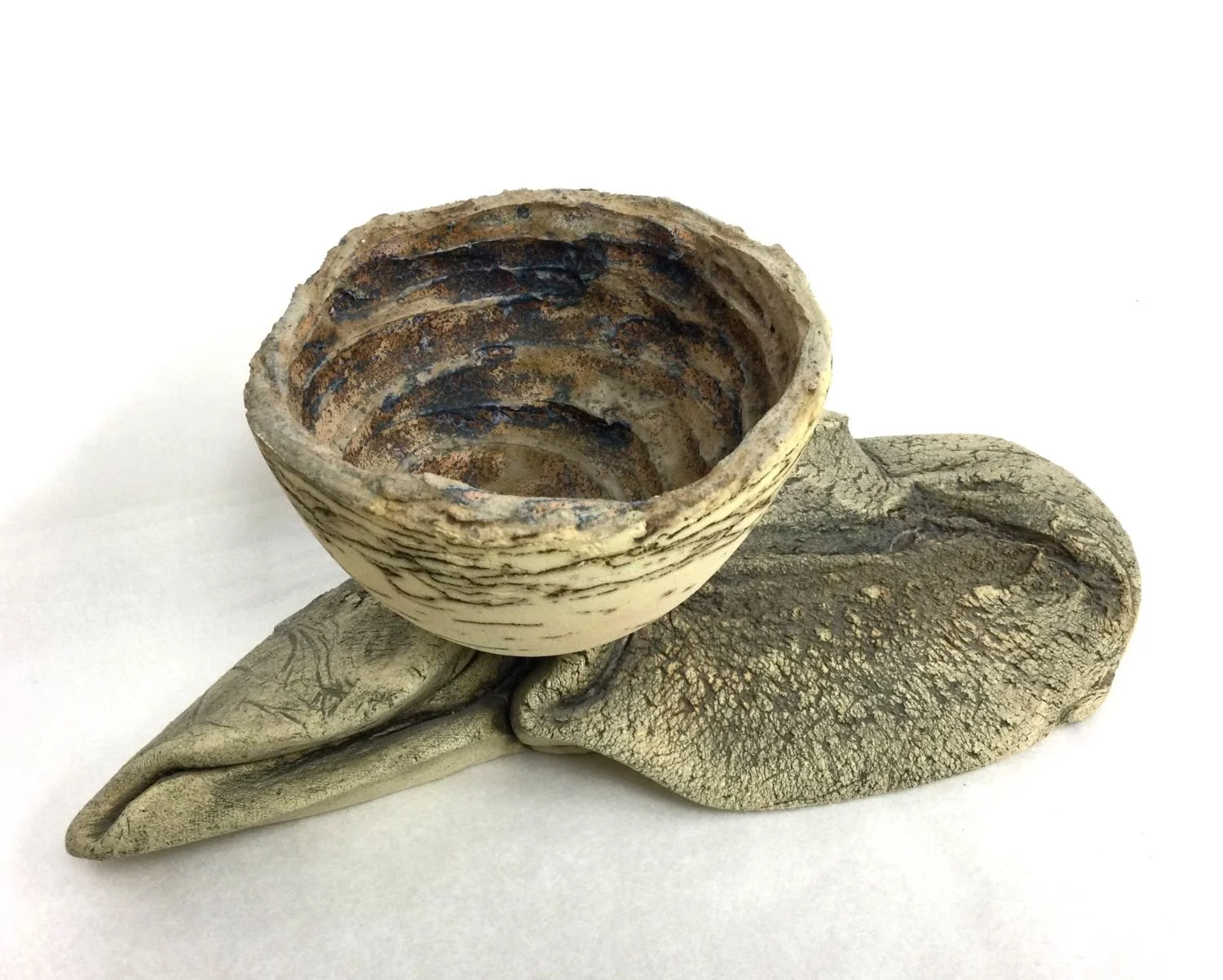
Mica Cup & Saucer, 2 pieces (13.3), paper clay, stoneware, oxides, glazes, 11.75 x 6 x 4.75 inches (30 x 15 x 12.5 cm), $750 Cdn.
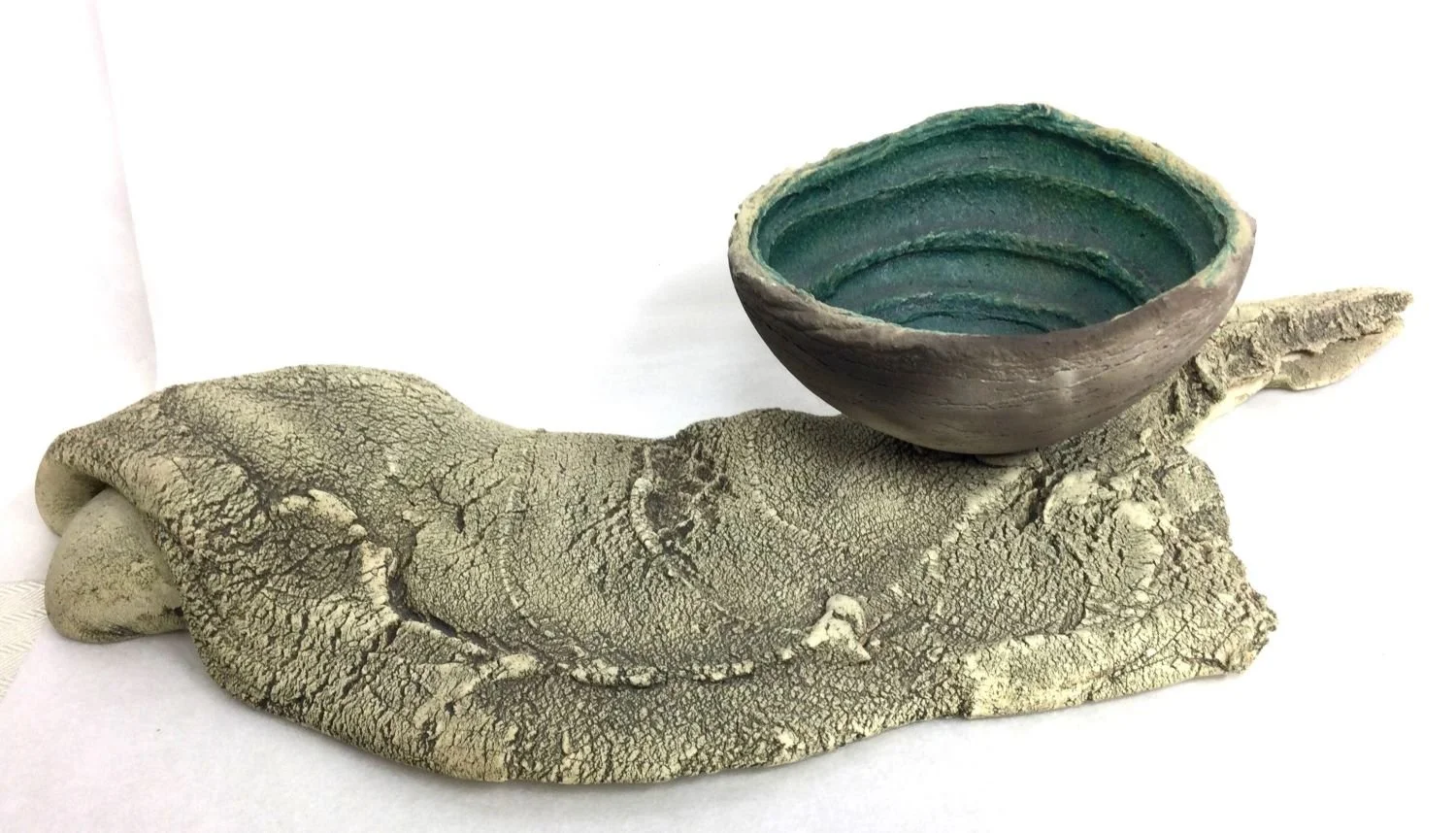
Green Cup & Saucer, 2 pieces (13.4), paper clay, stoneware, oxides, glazes, 17 x 8.75 x 4 inches (43 x 22 x 10 cm), $750 Cdn.

Red Whimsy Cup (23.1), stoneware, oxides, glazes, 5.5 inches (14 cm), $150 Cdn.
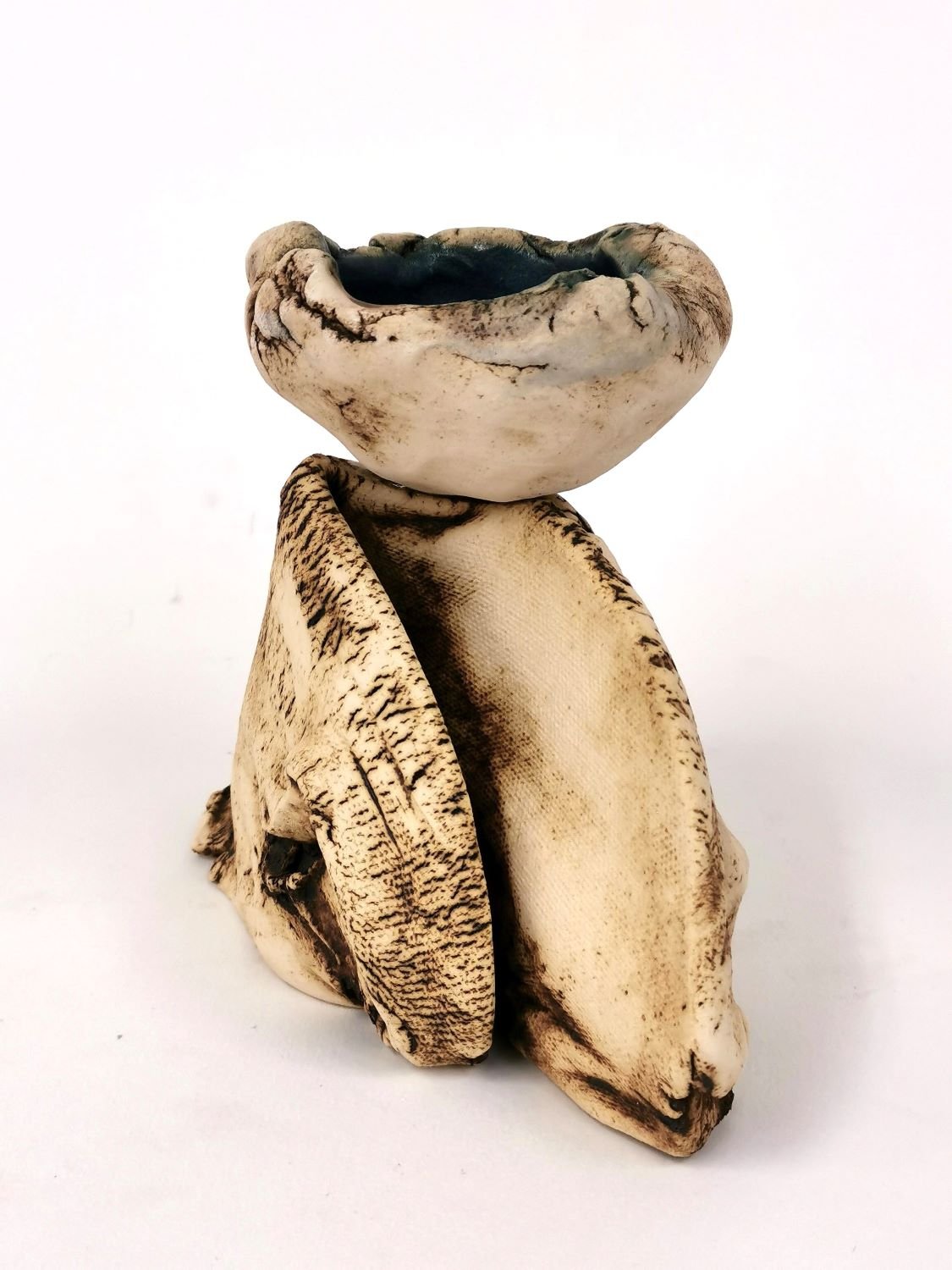
Short Blue Whimsy Cup (23.3), stoneware, oxides, glazes, 4 inches (11 cm), $150 Cdn.
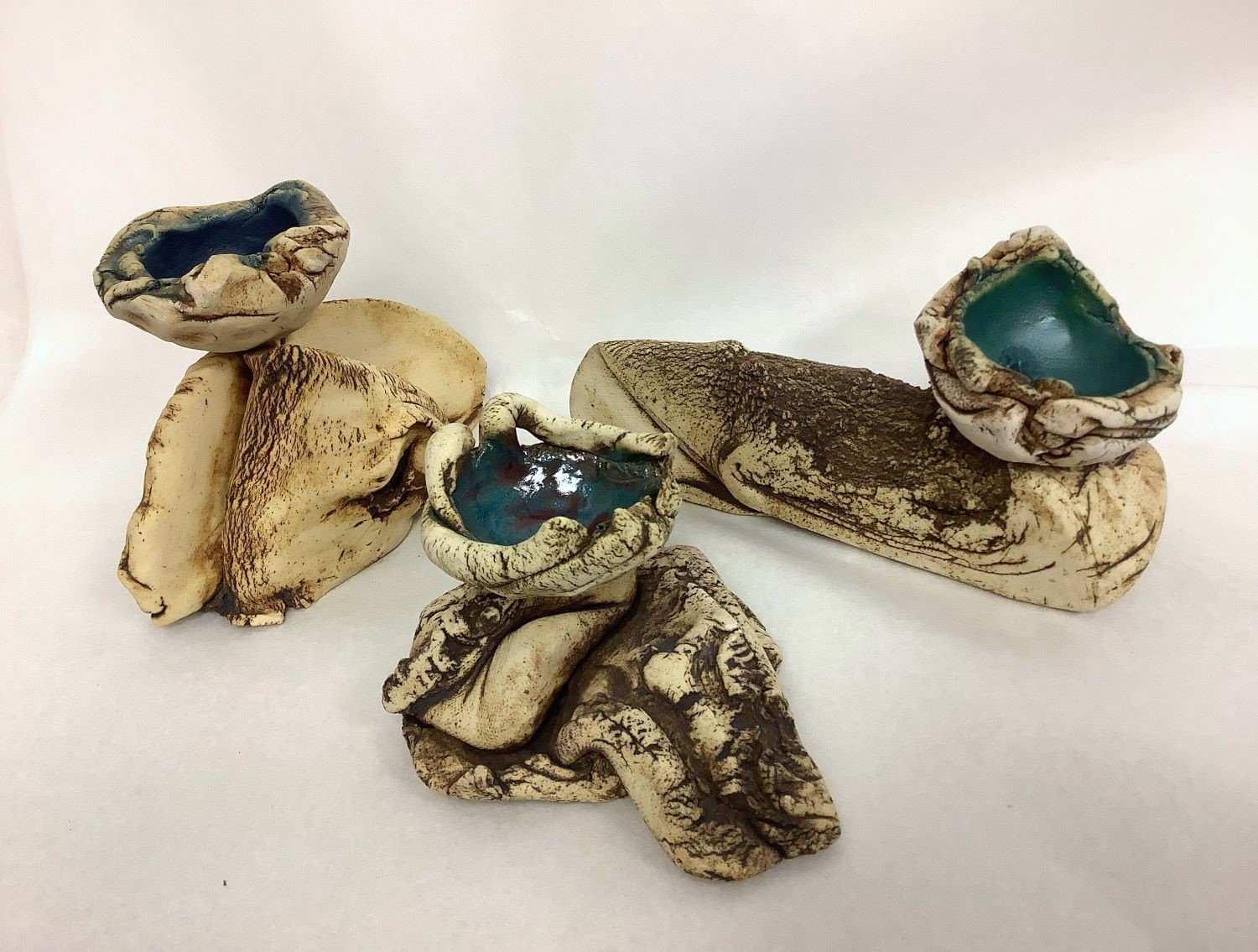
Grande Whimsy Cups (23.3, 9 & 10), stoneware, oxides, glazes, 5.5 inches (14 cm), $150 Cdn each.
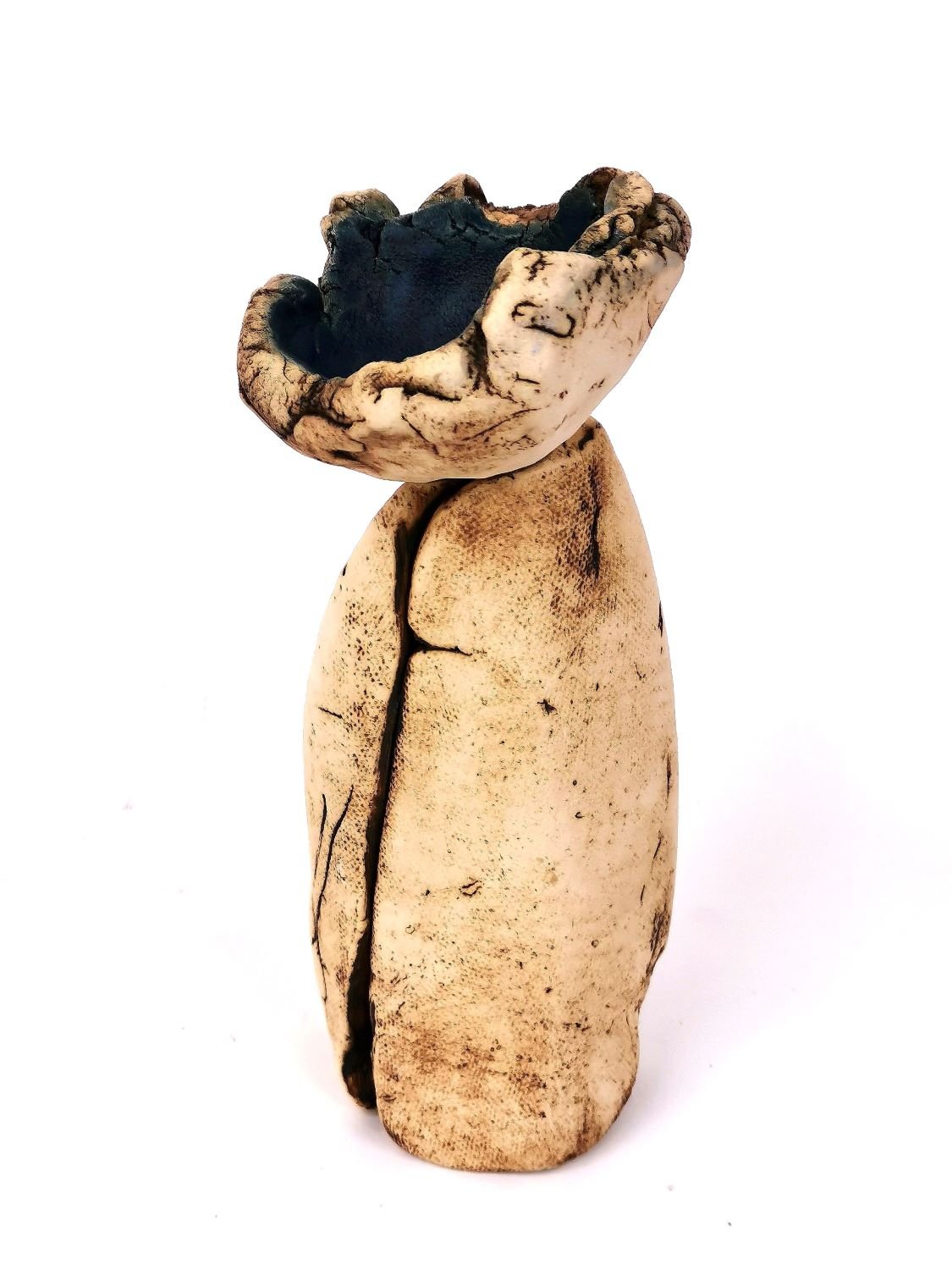
Tall Blue Whimsy Cup (23.6), stoneware, oxides, glazes, 6.5 inches (16 cm), $150 Cdn.

Aqua Blue Whimsy Cup (23.7), stoneware, oxides, glazes, 5 inches (12 cm), $150 Cdn.
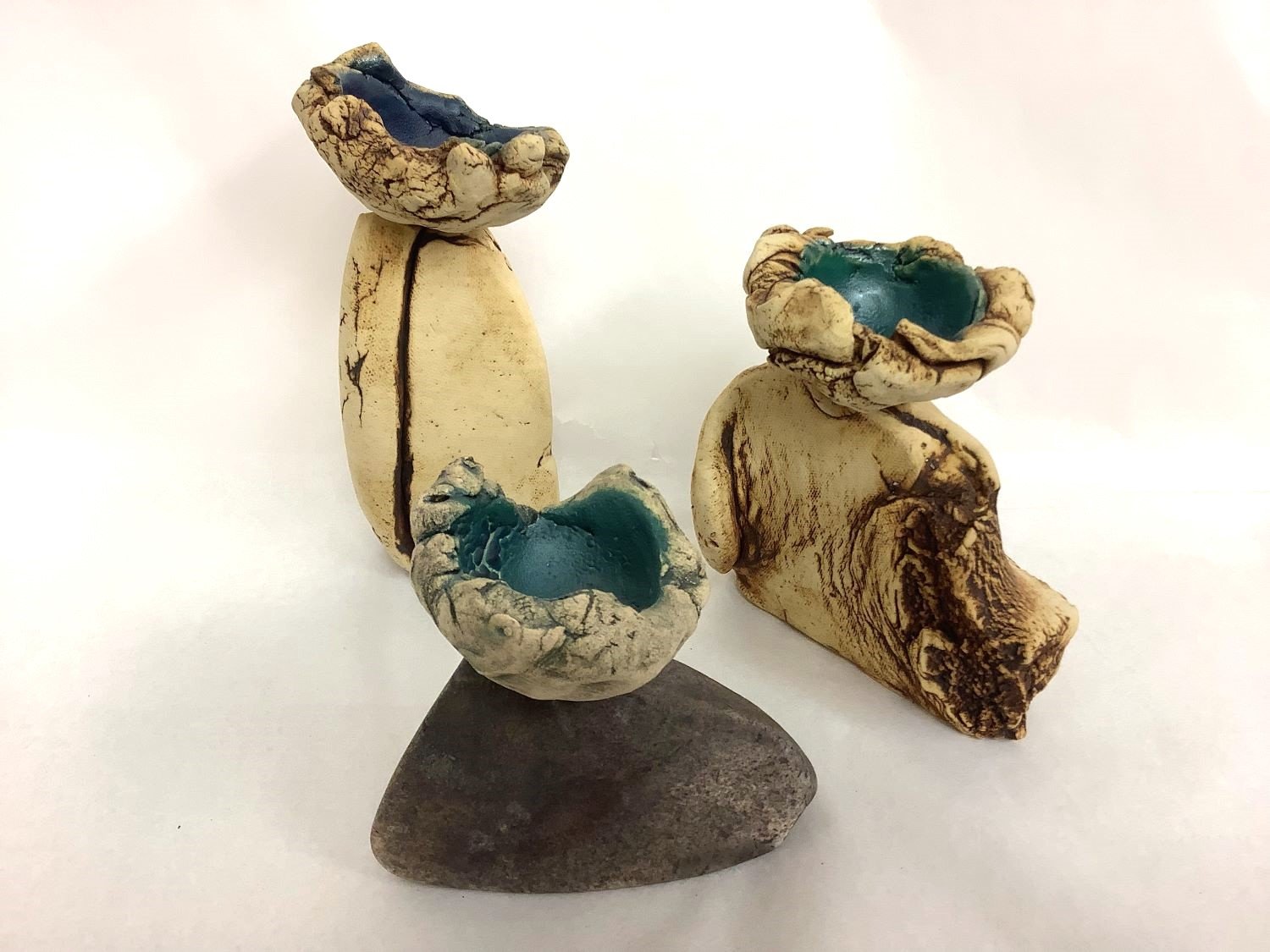
Grande Whimsy Cups (23.6, 16.7, 23.7), stoneware, oxides, glazes, 6 inches (15 cm), $150 Cdn each.

Burst Red & Blue (wall piece), oxides, paperclay, stoneware, glazes, wood, 52 x 12 x 8 inches overall (132 x 30.5 x 20 cm), $1500.00 Cdn.
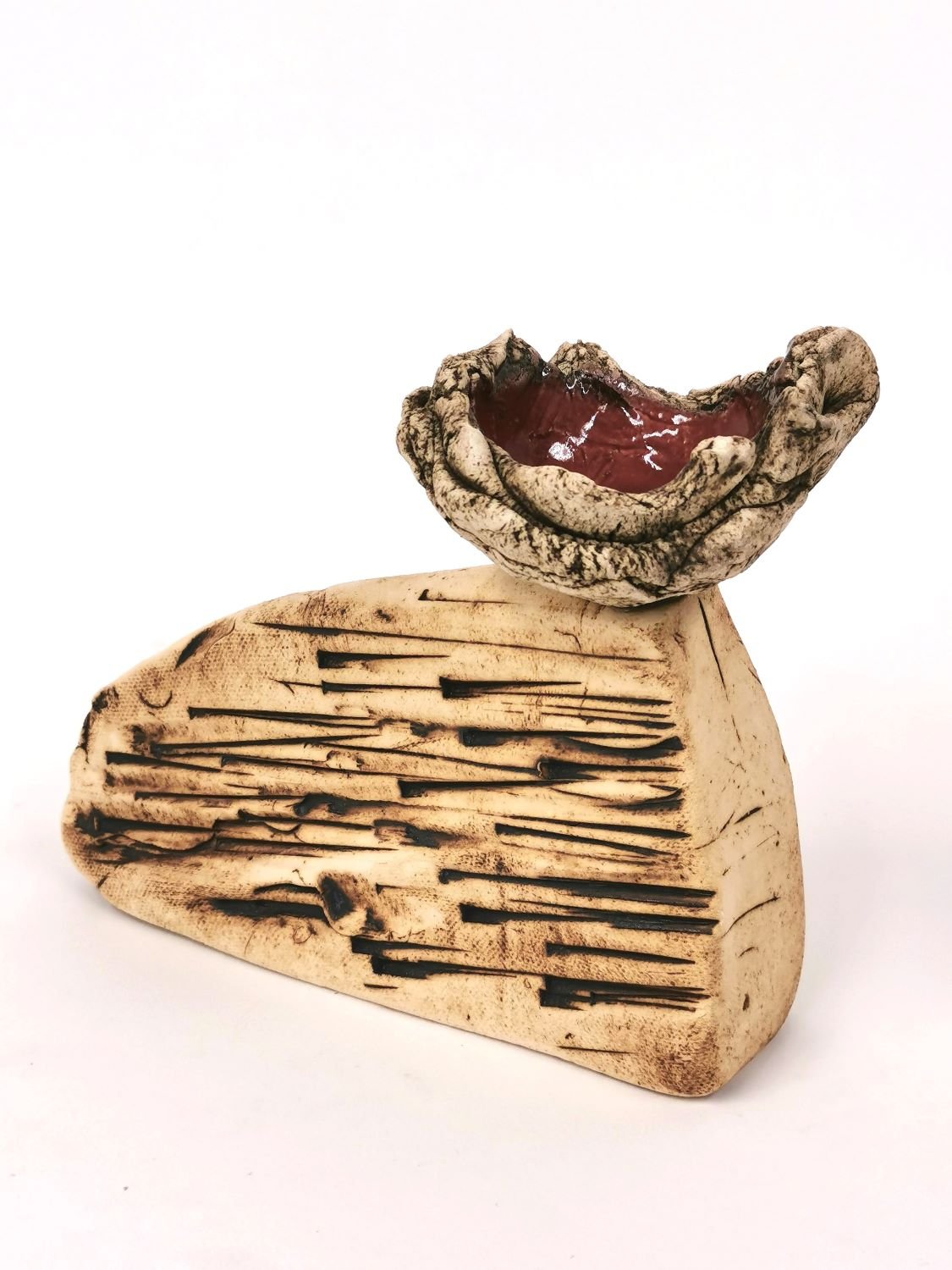
Short Red Whimsy Cup (23.4), stoneware, oxides, glazes, 5 inches (12.5 cm), $150 Cdn.
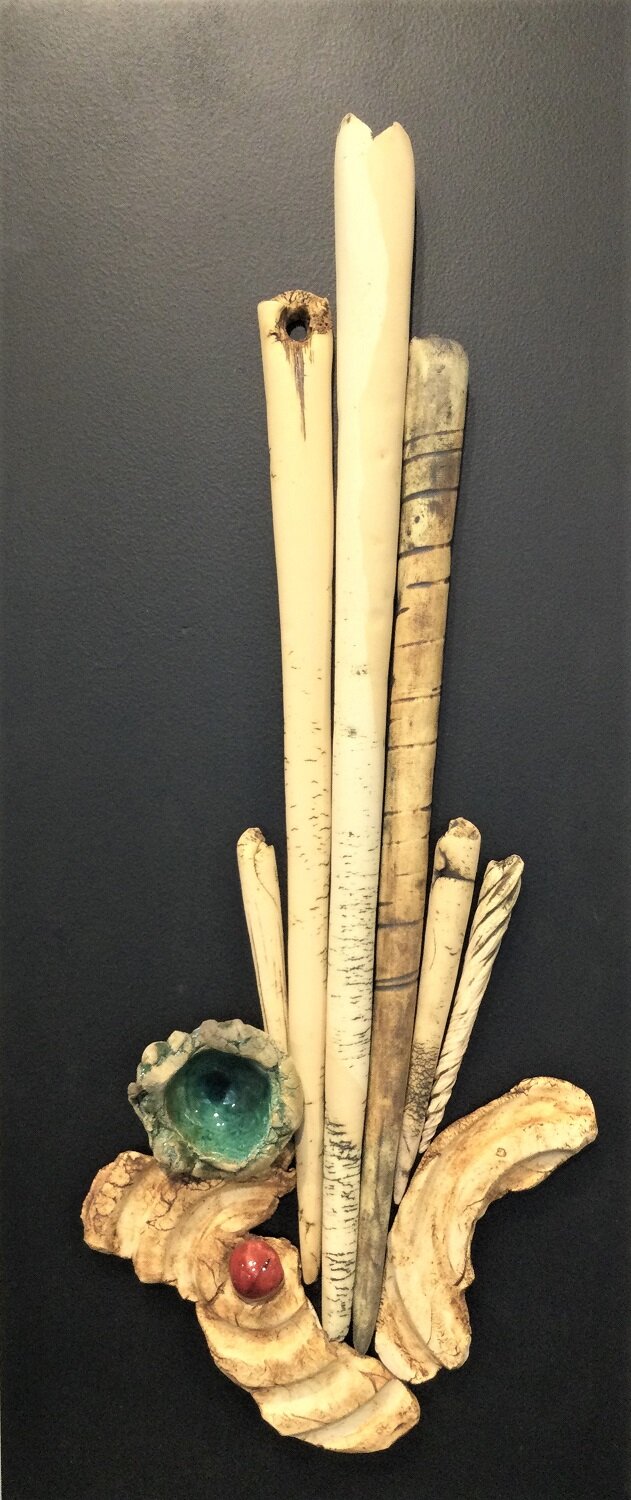
Growth (wall piece), oxides, paperclay, stoneware, glazes, wood, 26 x 11 x 2.5 inches (66 x 28 x 6 cm), $1100.00 Cdn.

Tall Red Whimsy Cup (23.8), stoneware, oxides, glazes, 8.5 inches (21 cm), $150 Cdn.
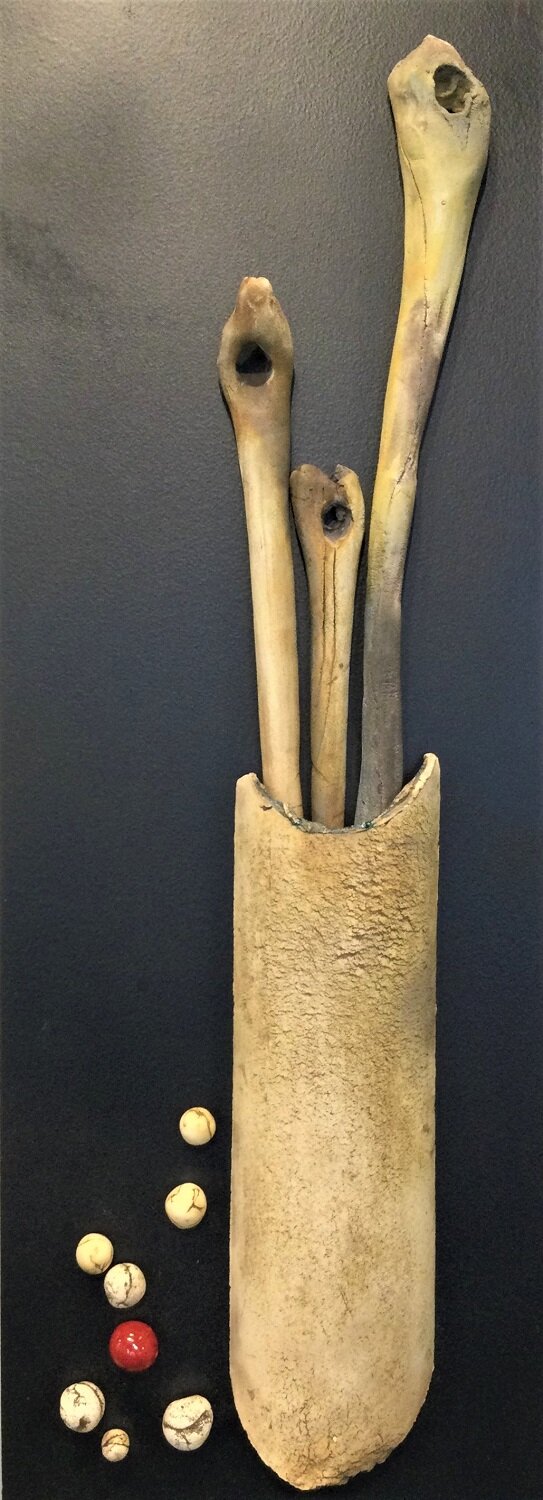
Fertility (wall piece), oxides, paperclay, stoneware, glazes, wood, 26 x 9.5 x 2.5 inches (66 x 24 x 6.5 cm), $1050.00 Cdn.
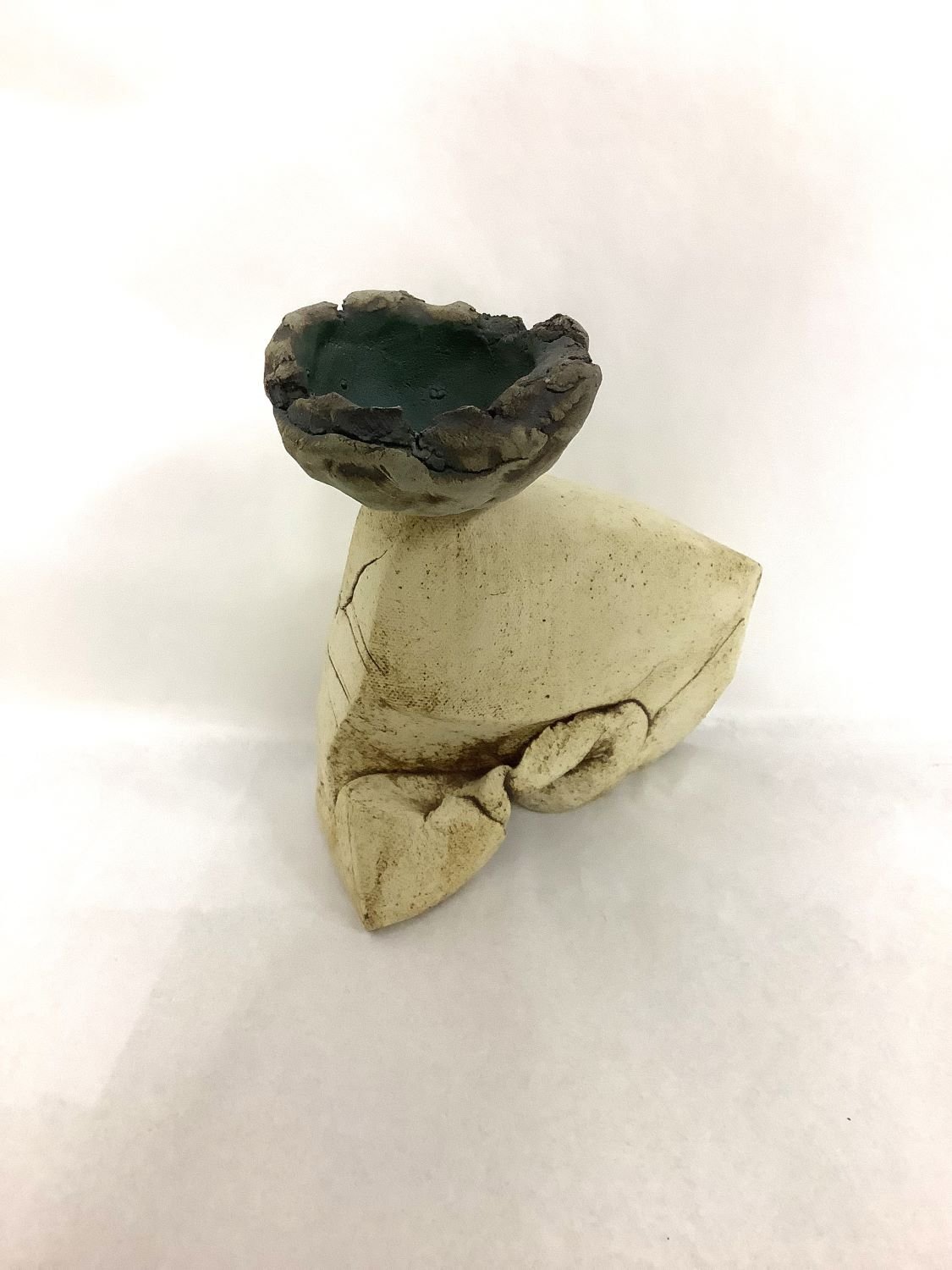
Dark Green Whimsy Cup (19.1), stoneware, oxides, glazes, 5.5 inches (14 cm), $150 Cdn.

Emergence (wall piece), oxides, paperclay, stoneware, glazes, wood, 26 x 9 x 4 inches (66 x 23 x 10 cm), $950.00 Cdn.
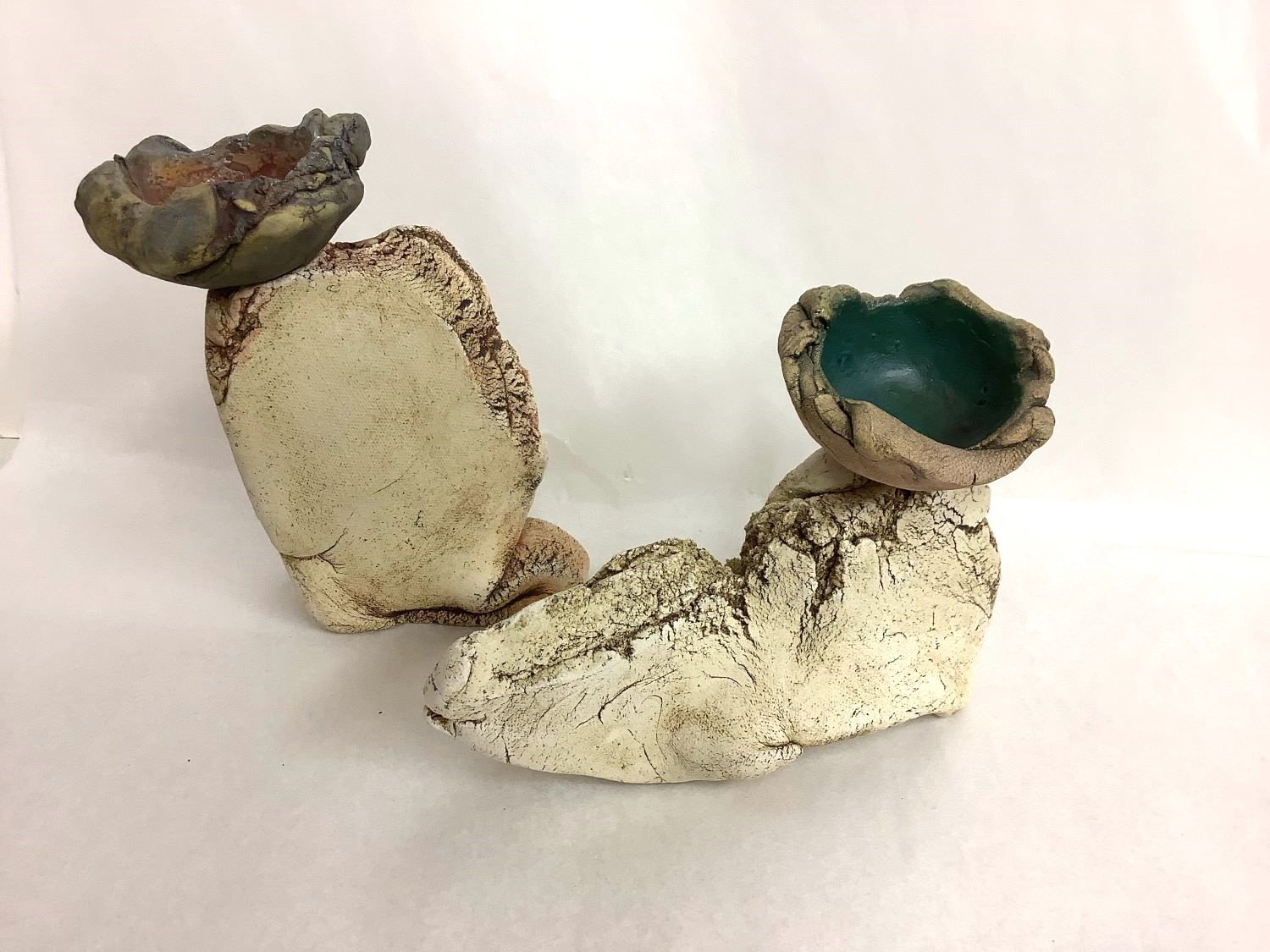
Grande Whimsy Cups (19.27 & 28), stoneware, oxides, glazes, 6 inches (15 cm), $150 Cdn each.
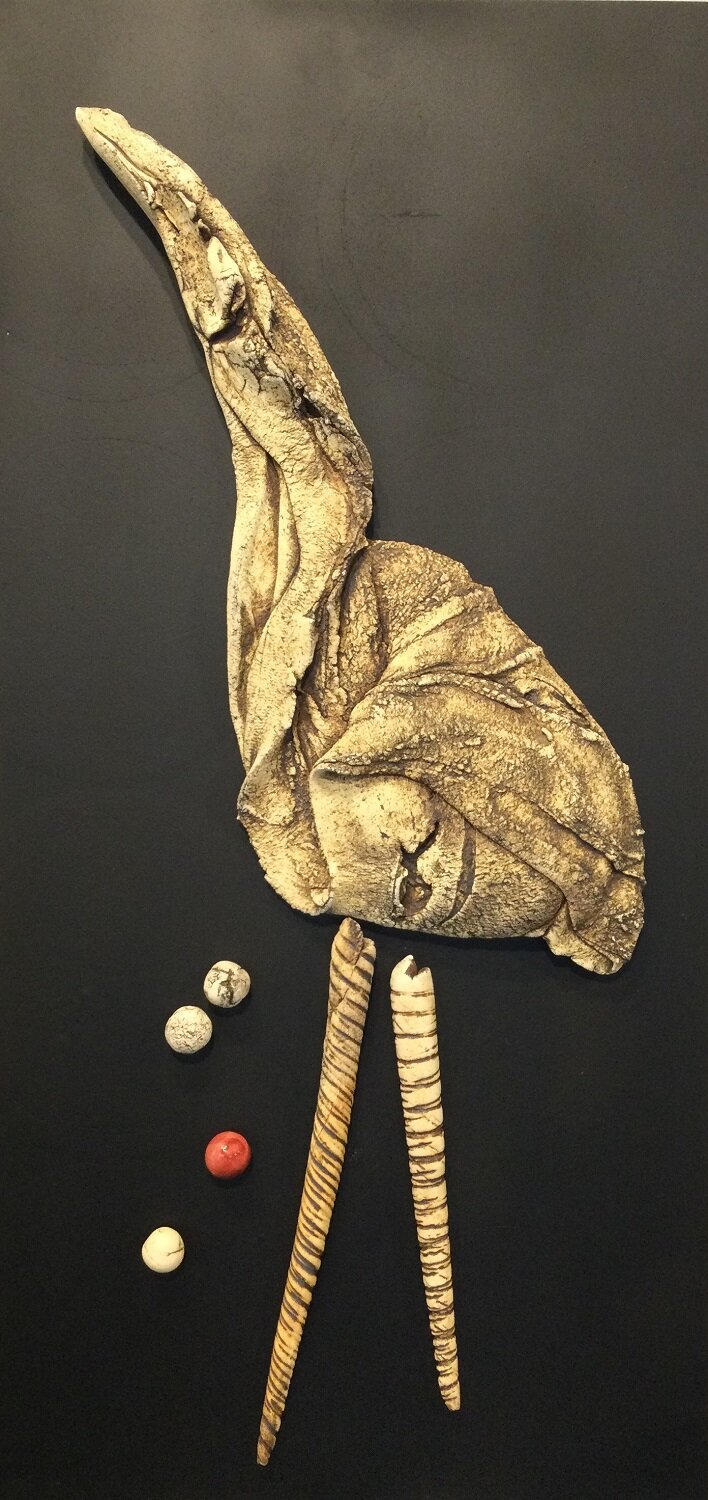
Bird (wall piece), glaze, paperclay, stoneware, oxides, wood, 27 x 13 x 2.5 inches (68.5 x 33 x 6.5 cm), $850.00 Cdn.

Cube (various sizes), stoneware, oxides, glazes, starting at $50 to $125 Cdn. (contact us about the available sizes).
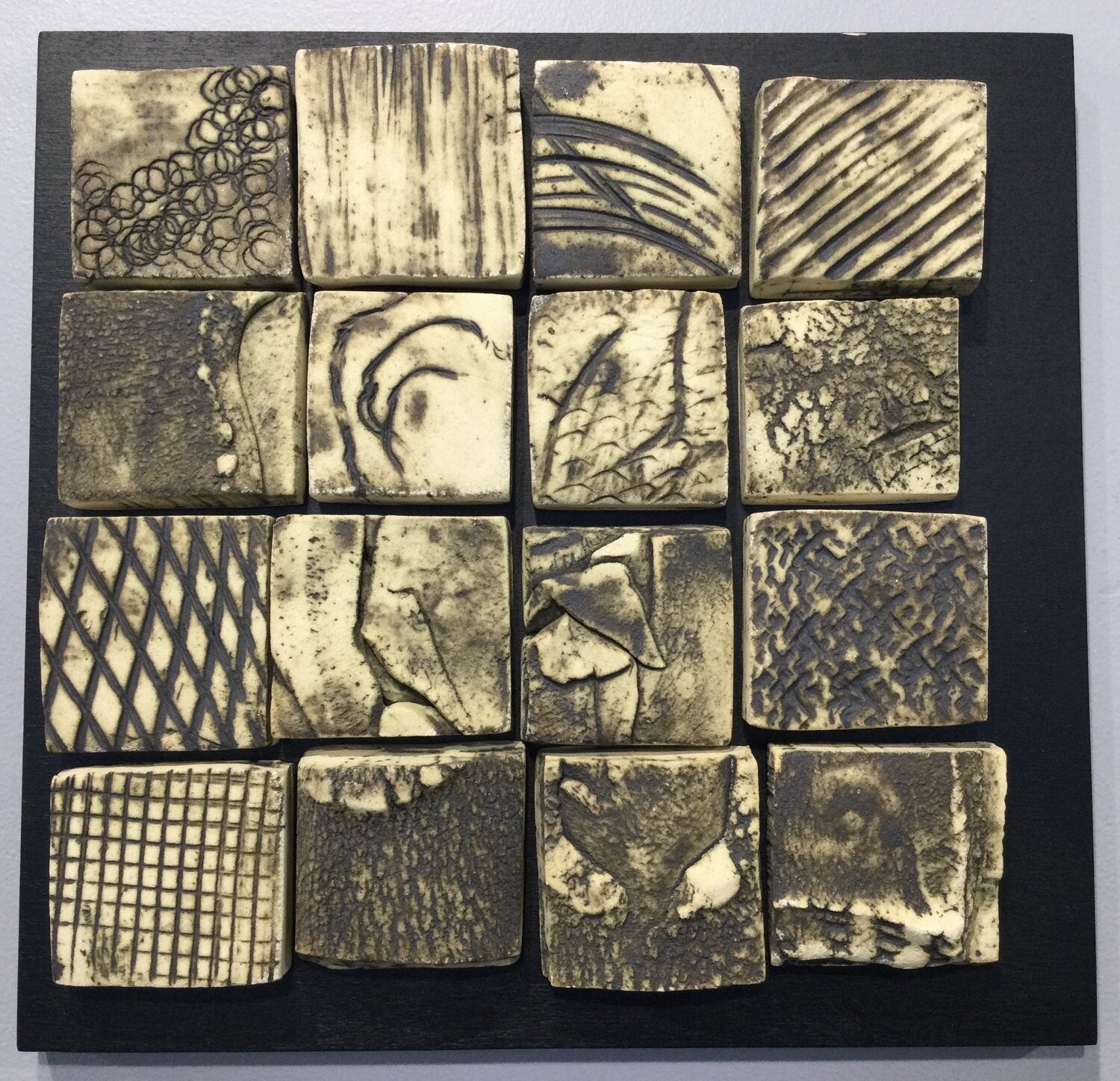
Sixteen Tiles (wall piece), oxides, stoneware, glazes, wood, 11.5 x 12 x 3 inches (29.5 x 30.5 x 8 cm), $650.00 Cdn.
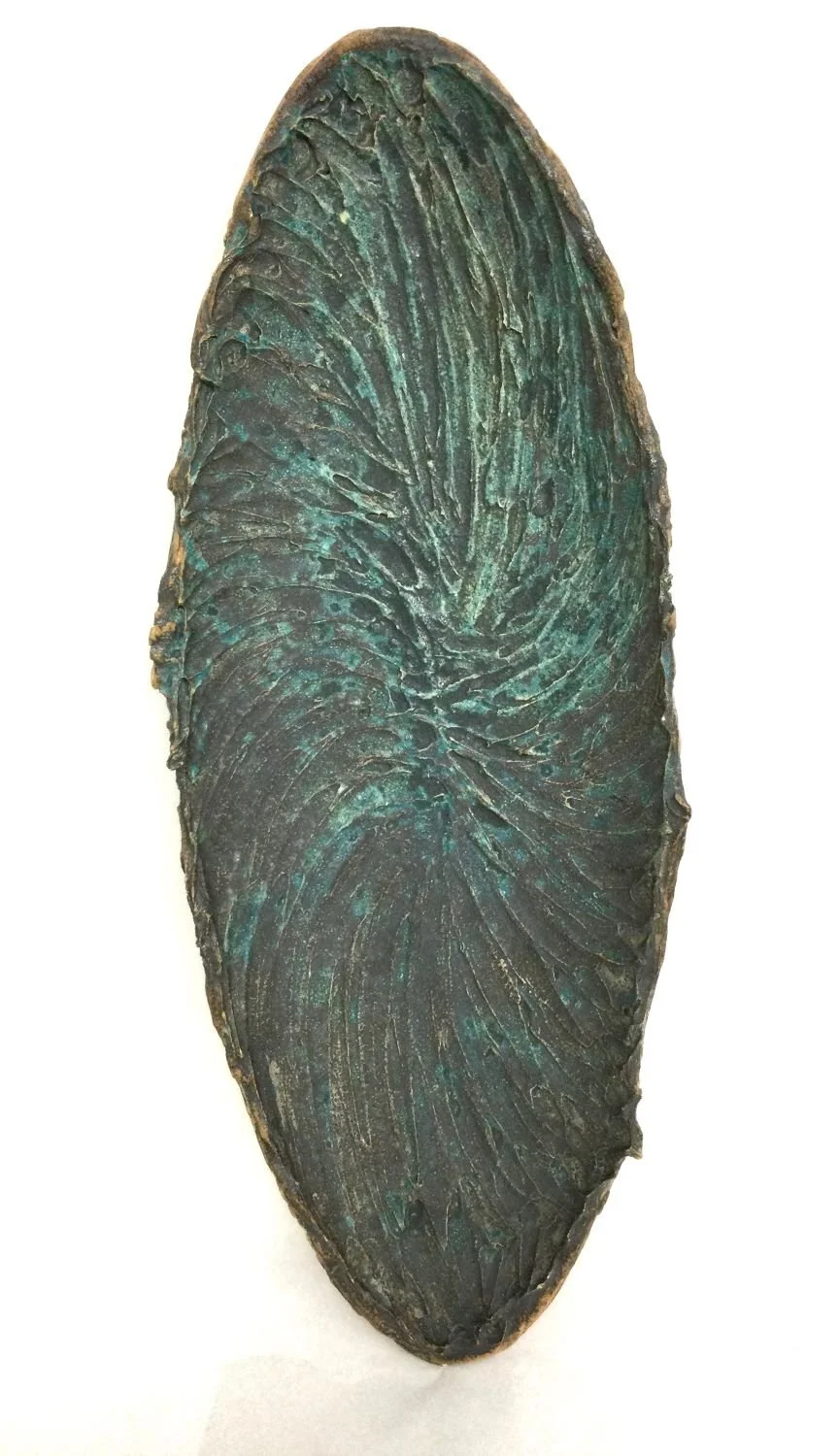
Blue Eclipse, paper clay, oxides, glazes, 2 x 8.5 x 21.5 inches, $650 Cdn.
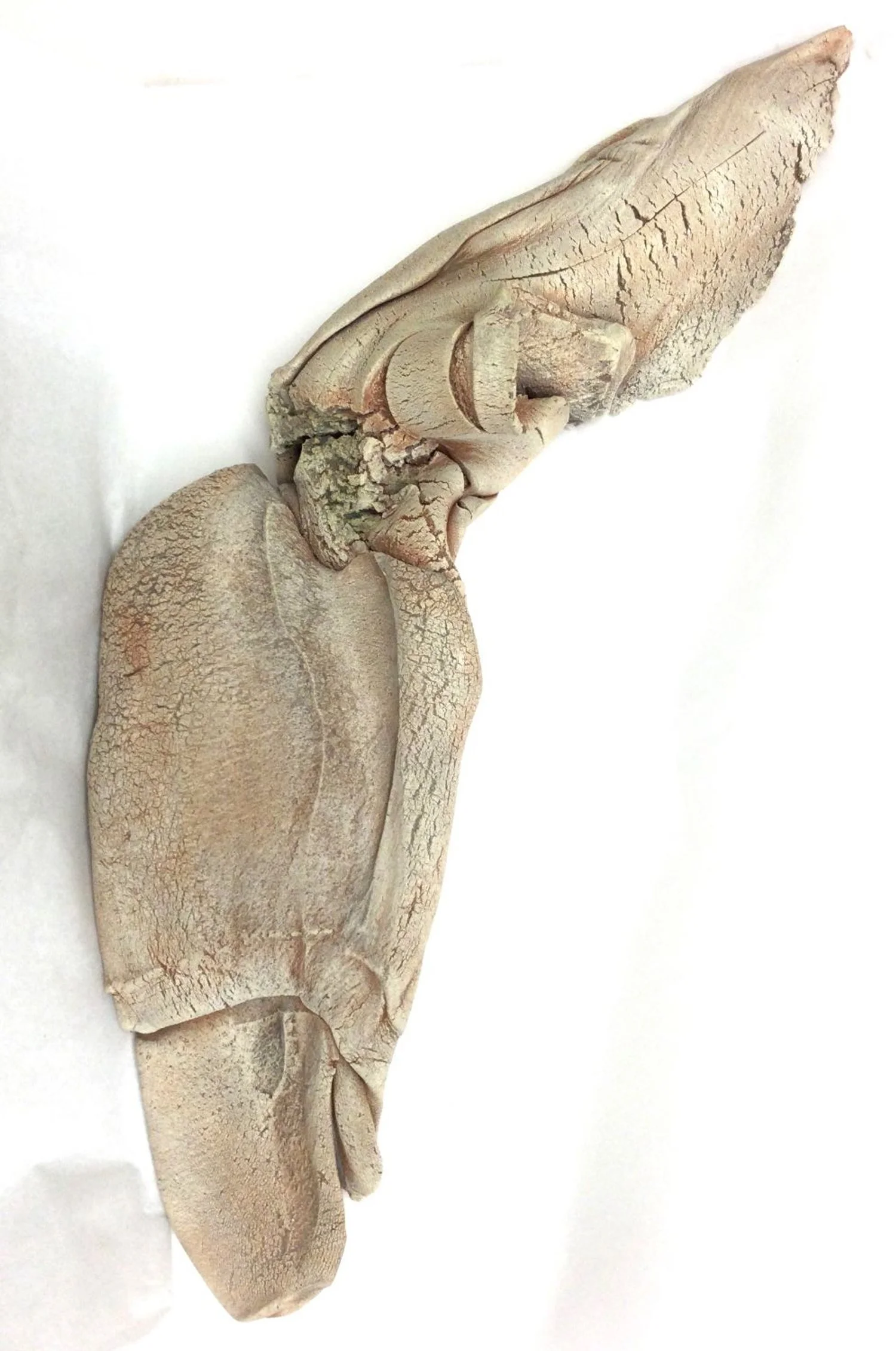
Flight (wall piece), stoneware and oxides, 21.5 x 8.5 x 4 inches, $800 Cdn.
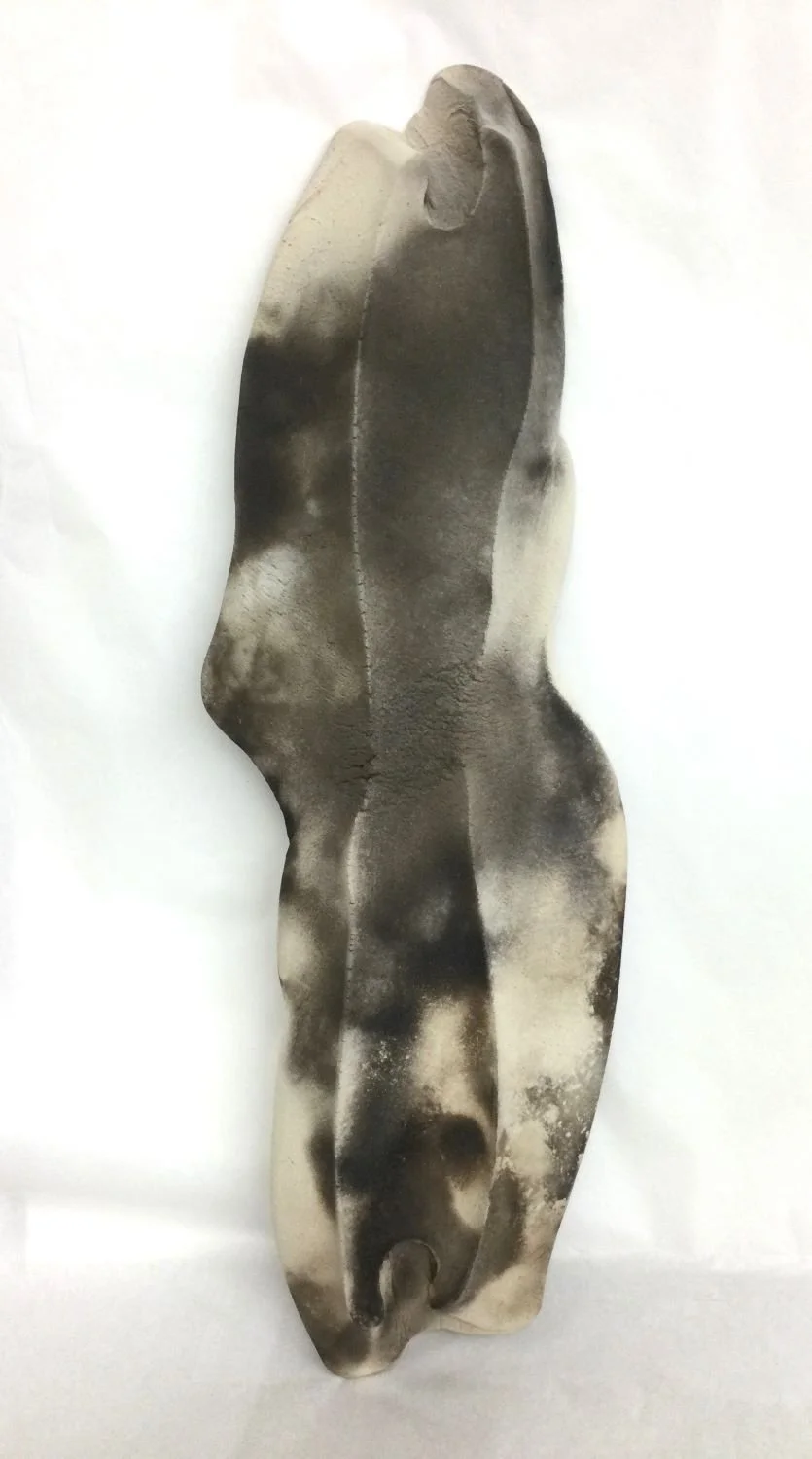
Clouds, c.2009, saggar-fired clay, 23.25 x 8 x 2 inches (59 x 20 x 5 cm), $550 Cdn.

Green Platter (wall piece), oxides, paper clay, glazes, 19 x 1.5 inches (48 x 3.5 cm), $750.00 Cdn.

Grail Wall Piece (20.6), c.2000, raku-fired clay, metallic oxides, 21 x 16 x 4 inches, $875 Cdn.
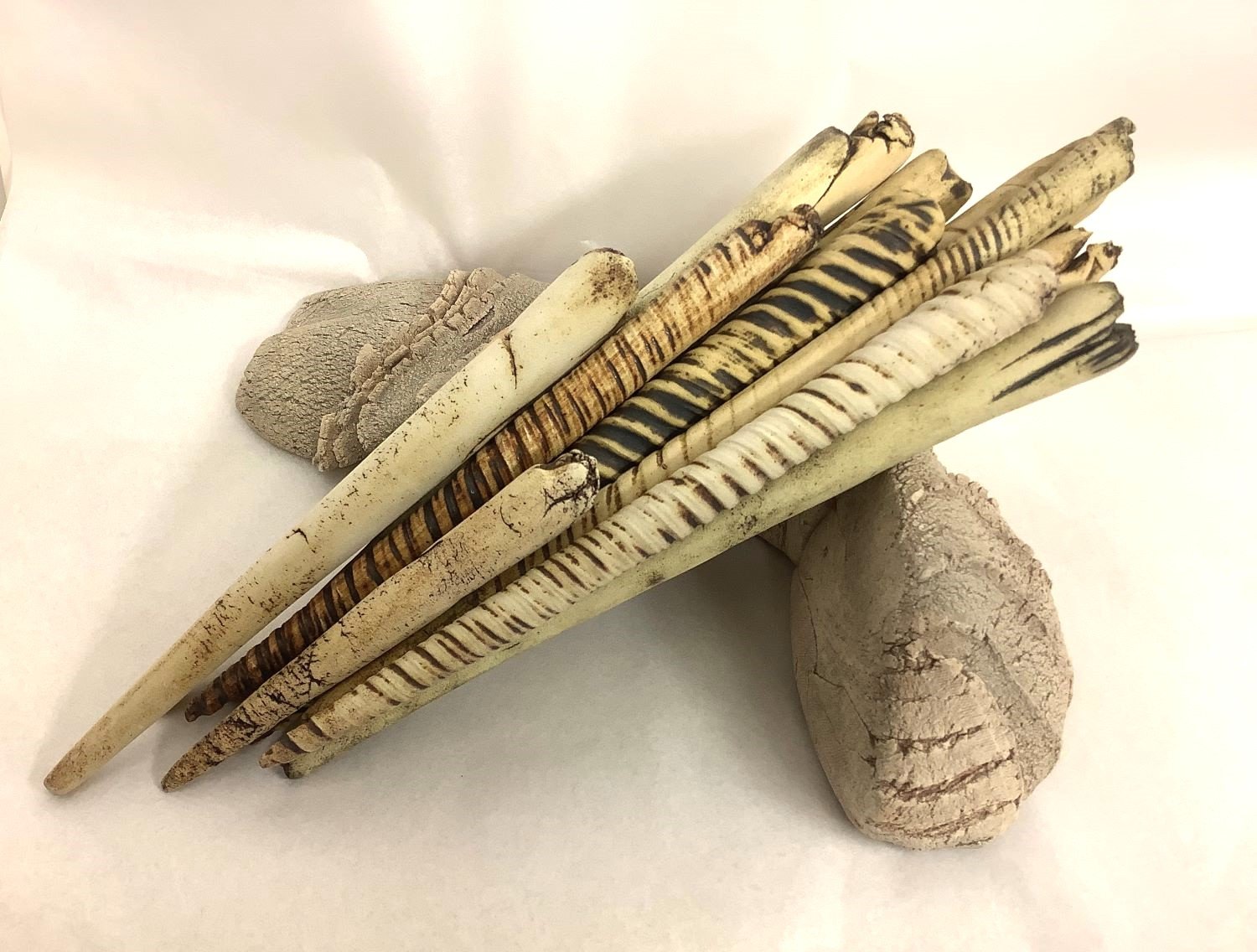
Waiting (13 pieces), paperclay, stoneware, glazes & oxides, overall 5.5 x 12 x 12 inches (14 x 30.5 x 30.5 cm), $775 Cdn.
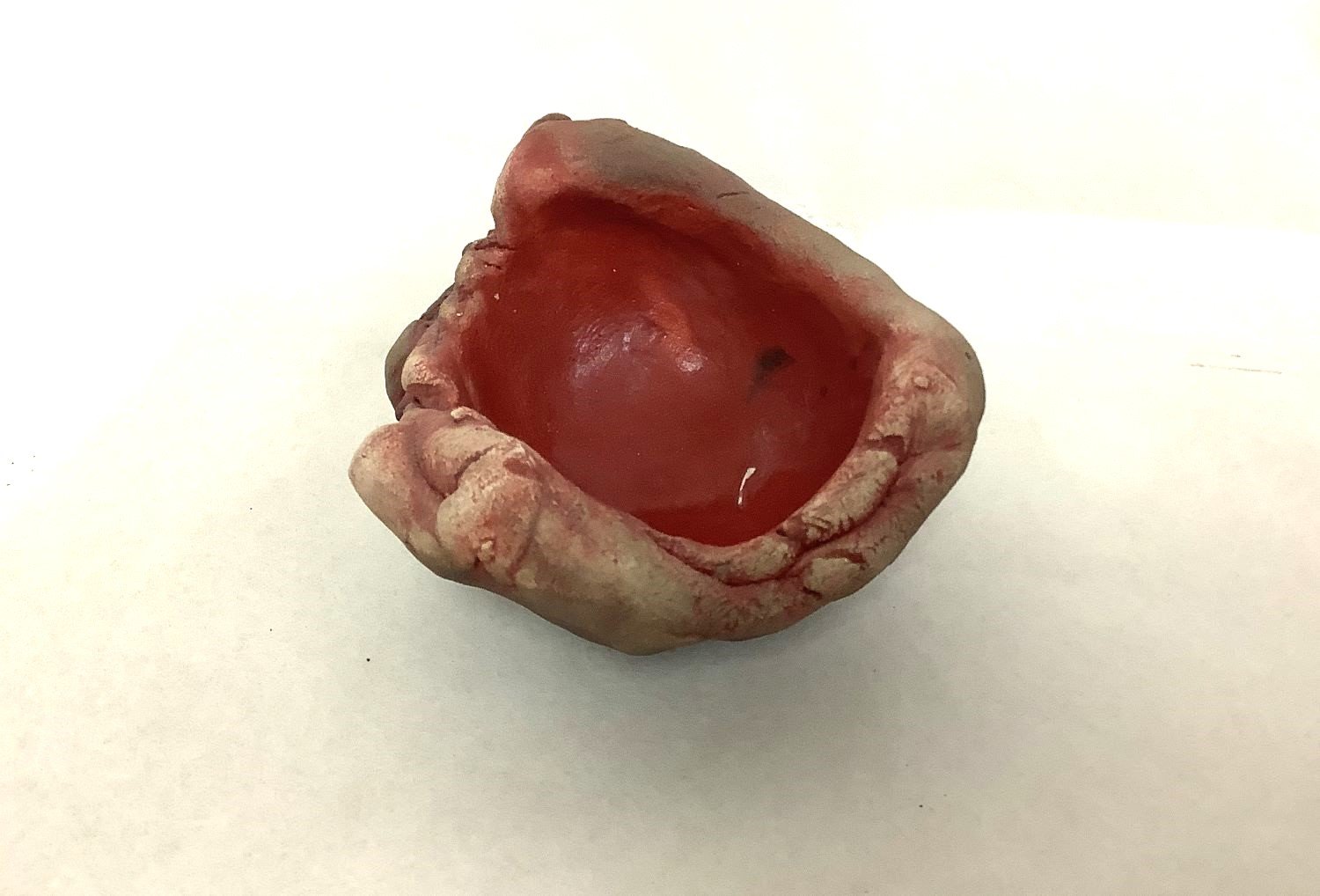
Small Whimsy Cup (23.11), paper clay, glazes, oxides, 1.5 x 3 x 3 inches (3 x 7.5 x 7.5 cm), sold.
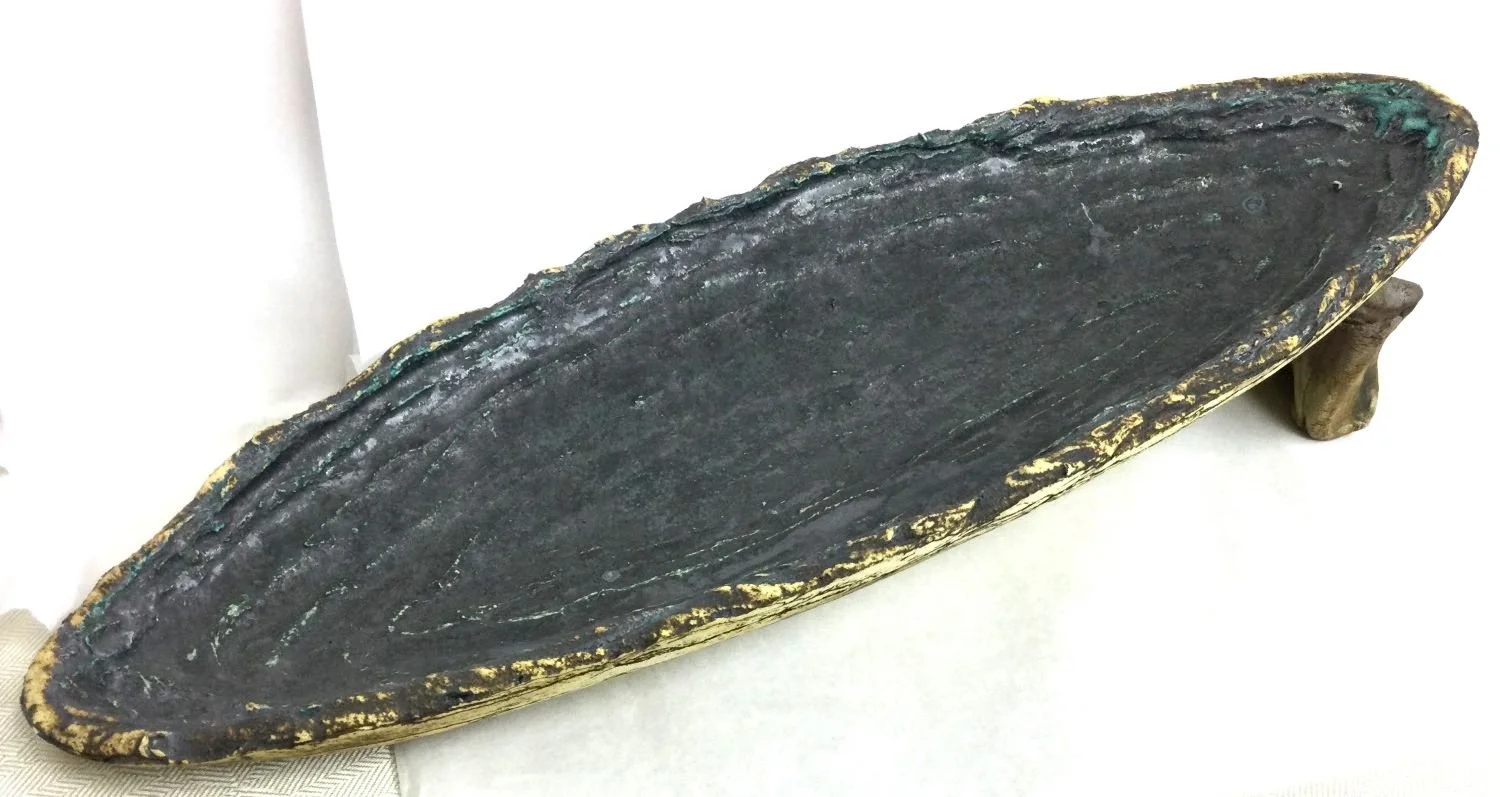
Contours (#12.11) (two pieces), paper clay, oxides, glazes, 22 x 8 x 4 inches, sold.
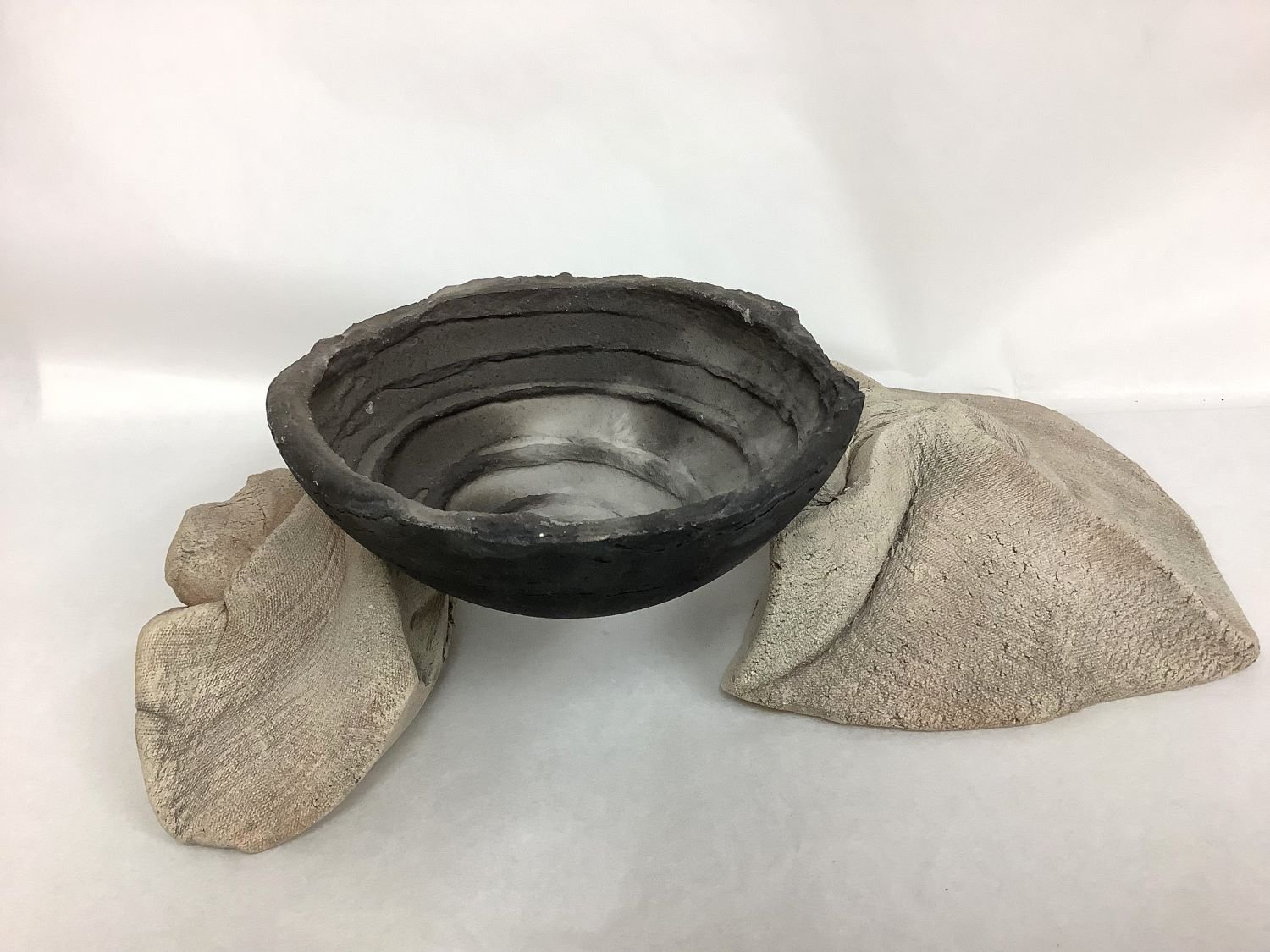
Dark Canyon Cup & Saucer (14.2), paper clay, raku, 4 x 11.5 x 8 inches (10 x 29 x 20.5 cm), sold.

Turquoise Nesting Bowl, 3 pieces (19.20), paperclay, oxides, glazes, 2.5 x 5.5 x 5.5 inches (6.5 x 14 x 14 cm), sold.
“I was mesmerized”
The first time the artist saw someone throw a pot began a life-long fascination with, and dedication to, working with clay. “I was mesmerized by it and wanted to try it. I still have the first pot that I threw on the wheel thirty years ago, because it actually worked out. I think it was beginner’s luck, but I was hooked.” The process, the aesthetic, the tactile medium spoke to him from the very start and in turn, he uses this medium as a way of helping people (re)discover and explore their own creativity, both personally and professionally.
Ed’s ceramic works take inspiration from numerous sources, including the canyonlands of the American southwest, historical sites in Europe and elsewhere, the legacies of “lost” or ancient cultures, and the shapes and colours of the natural world, to name a few.
His sculptural pieces embrace the textural qualities of clay and its capacity to reflect the natural world. They sometimes allude to function, while remaining firmly in non-functional territory. He has often used paperclay as one medium of choice. In this process, paper pulp is added to the chosen clay body. Cellulose fibres in the paper serve to make the clay more resistant to cracking and allow more risk-taking in creating the forms. Metallic oxides and low-temperature glazes are frequently used to animate the surfaces, with firings taking place in electric, raku and soda kilns.
In addition to his personal work, Ed has lectured and conducted ceramic workshops in Canada, the US, Mexico, Greece and Korea. He has also participated in international ceramics symposia in the US, Mexico and Greece. In addition, he has travelled extensively and done personal research in Central America, the Four Corners area of the American Southwest and a number of European sites. Ed has exhibited widely in solo and group exhibitions, both nationally and internationally. He is represented in public collections in Canada and Mexico, and in private collections in Canada, the United States, Mexico, Japan, Korea, Australia, and several countries in Europe.
Ed is the Ceramics Facilitator with the Visual Arts Program at Banff Centre for Arts and Creativity, in Banff, AB. His responsibilities include overseeing all the facilities of the Ceramics studio as well as consulting with and assisting resident artists from around the world in successfully meeting their project goals.
Ed has also had a long affiliation with the Leadership Department at Banff Centre in both public and private sector programs, using clay as a vehicle to explore personal and organizational creativity.
Statement:
Rock; fire; eroded earth; the patina of time on old buildings; the "knowing" of things which can't be defined - this is inspiration for me. I respond to the texture of clay, its plasticity, its ability to act as historical document.
Some of the current work references ongoing themes of landscape, the undulating forms in nature. Platters and bowl forms embrace a more diverse and vibrant use of colour, which gives me great pleasure. I want more. The figures in the Dreamers are new, simple and unpretentious, but for me, feeling at once very personal and very expansive in their presence. I look forward to discovering more.
